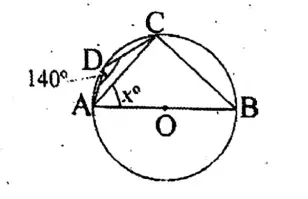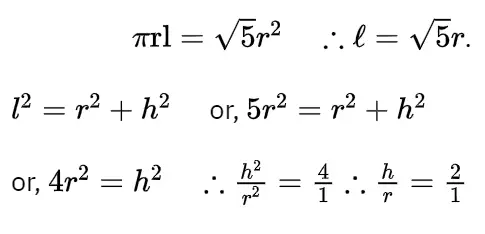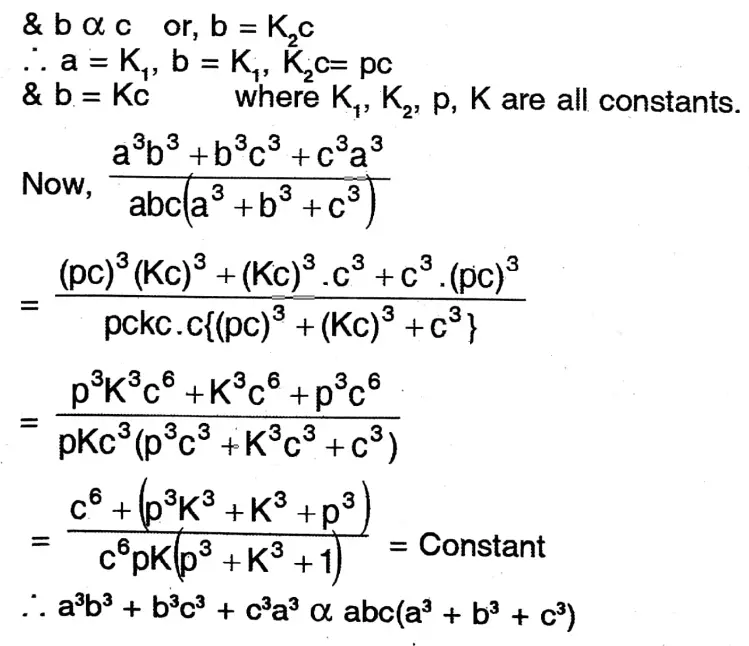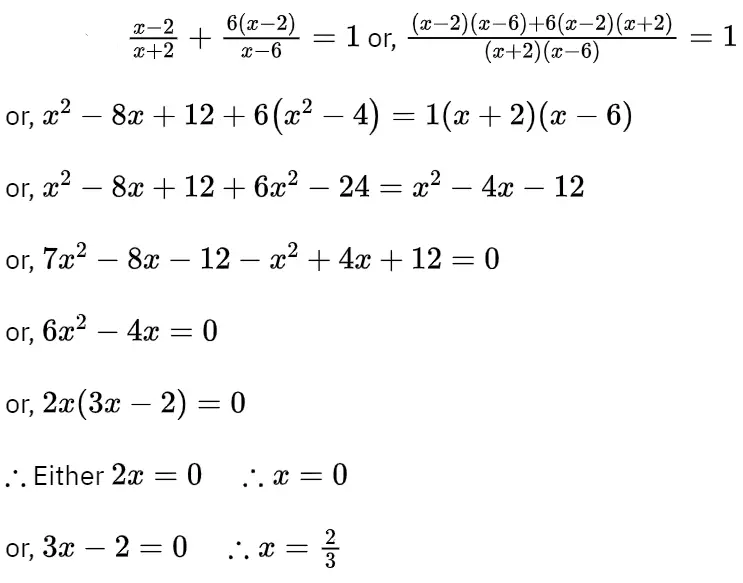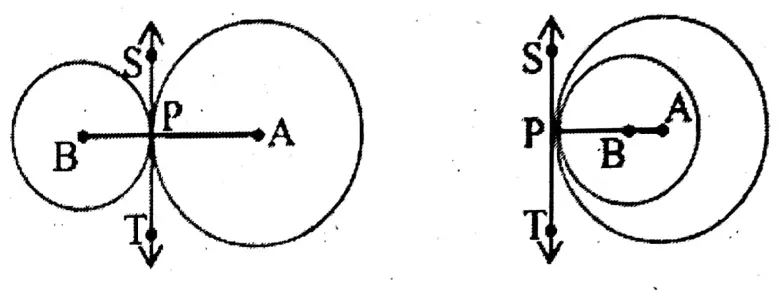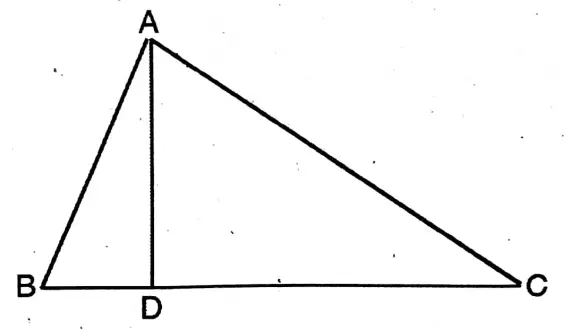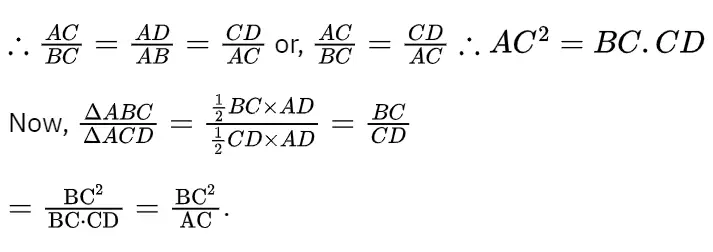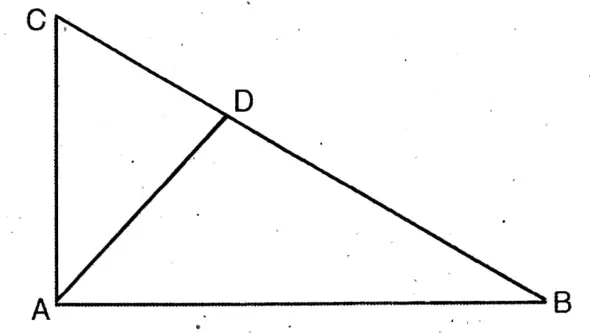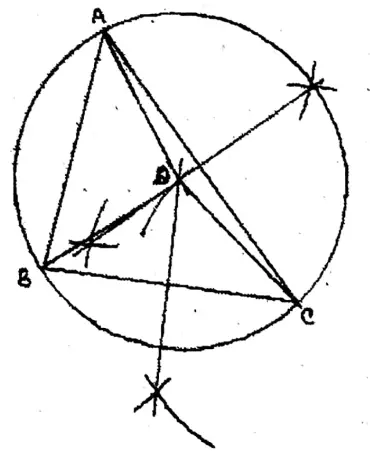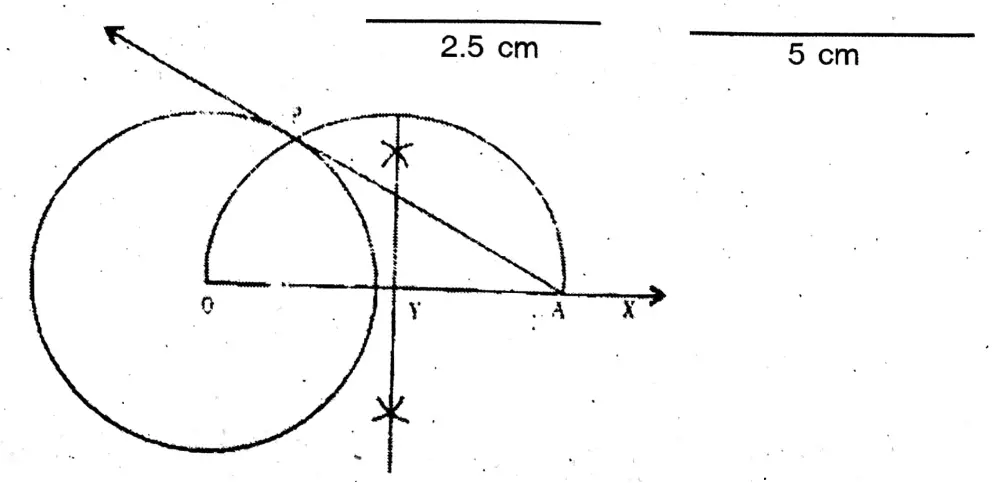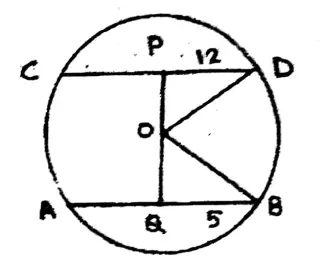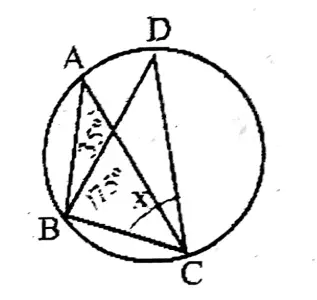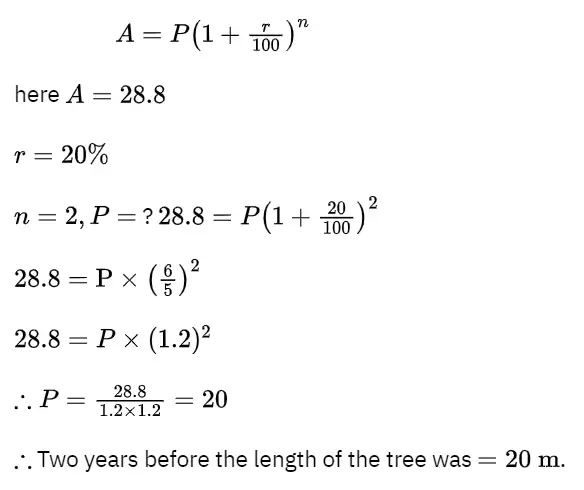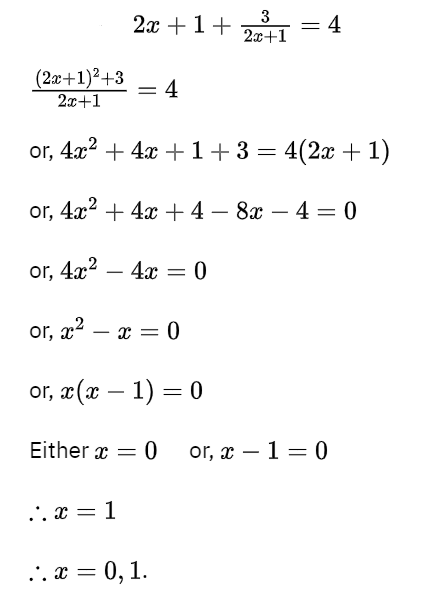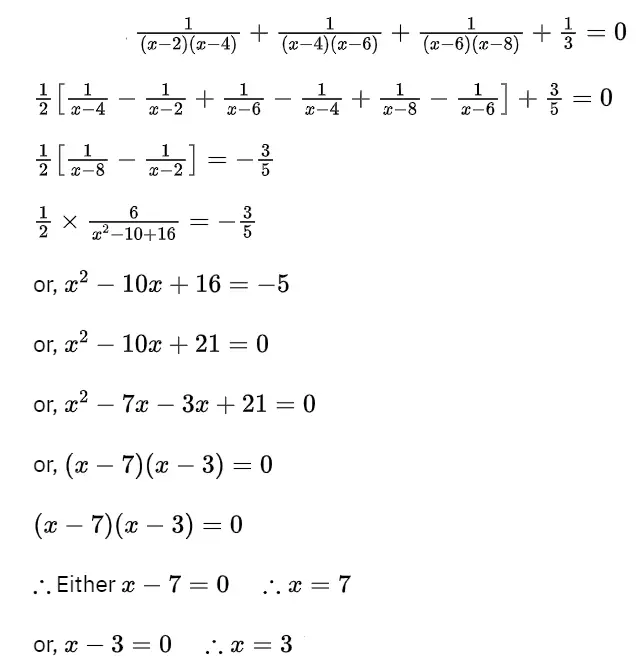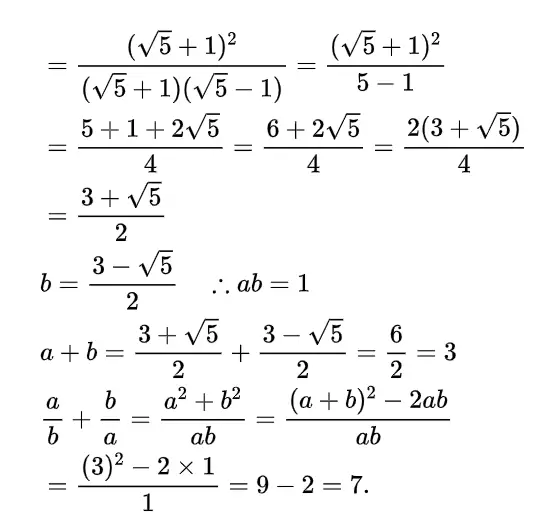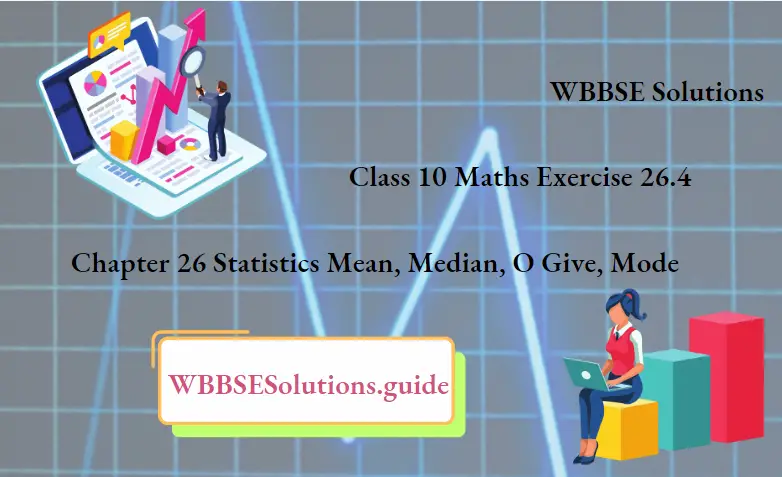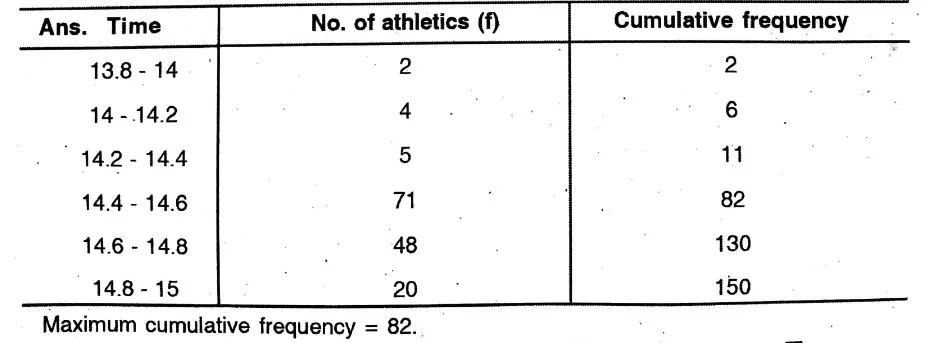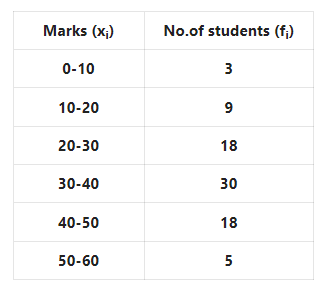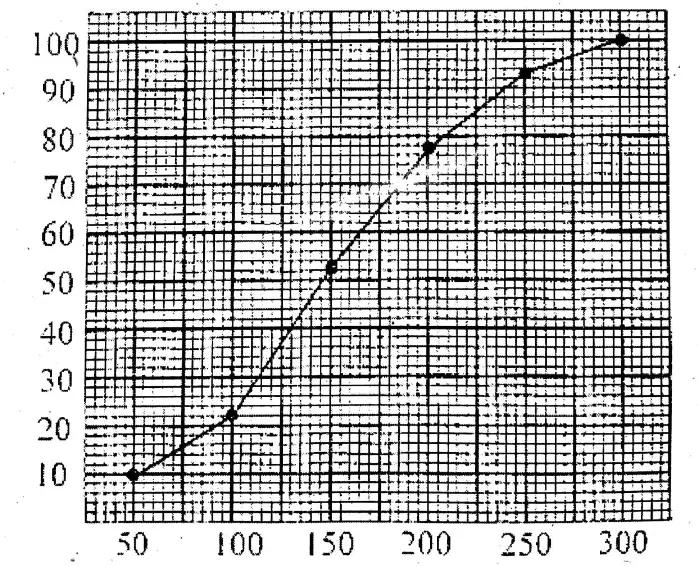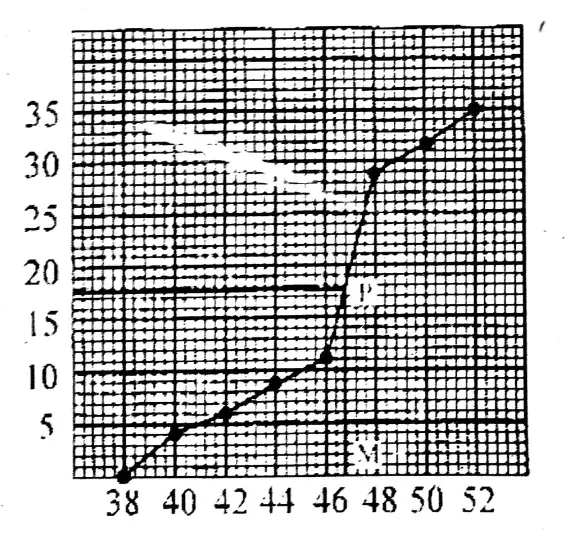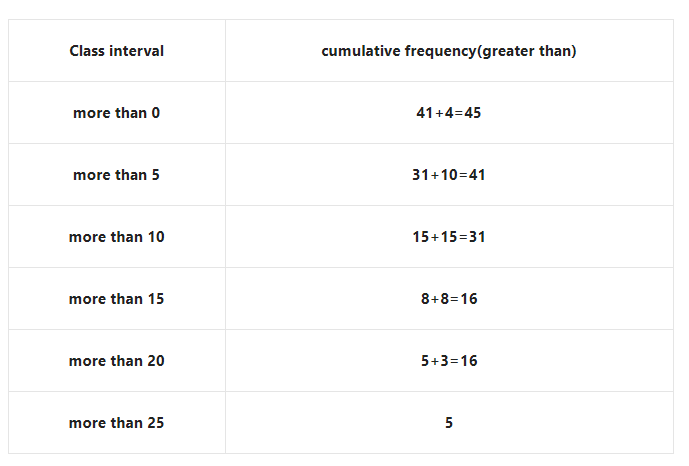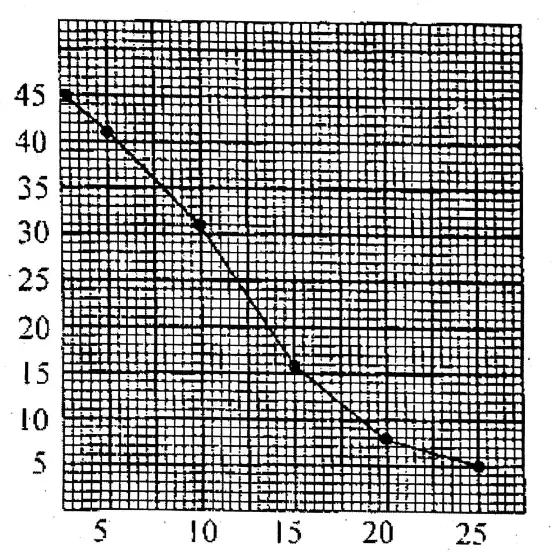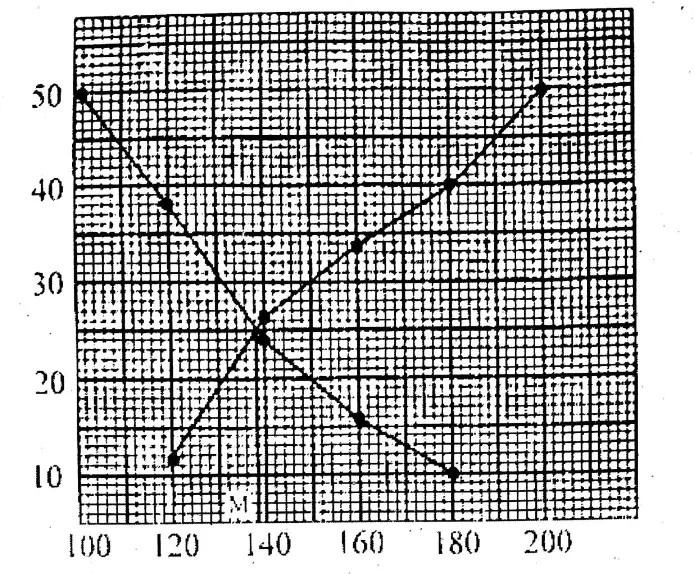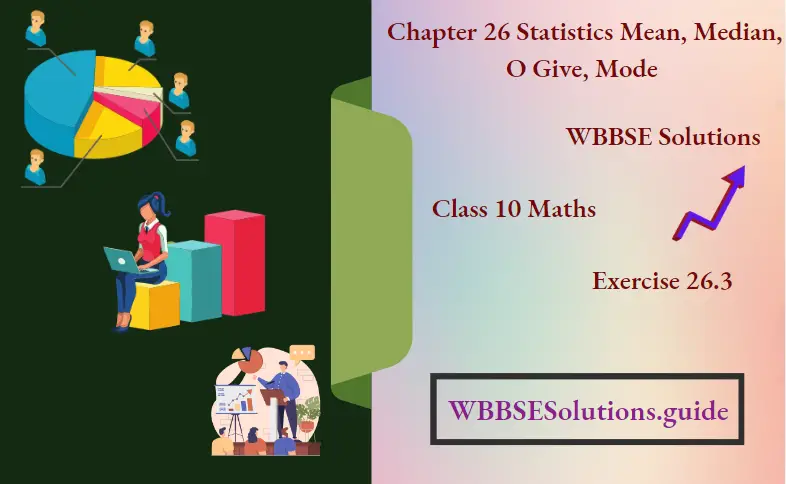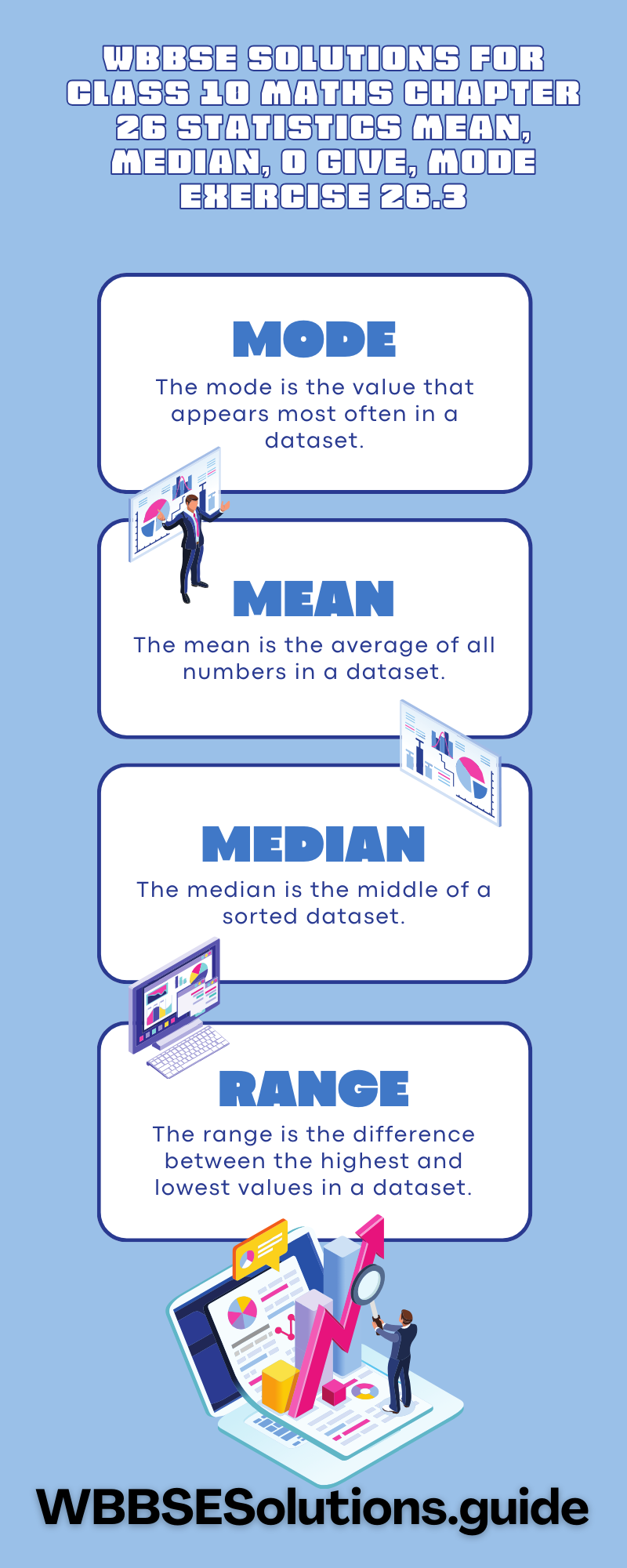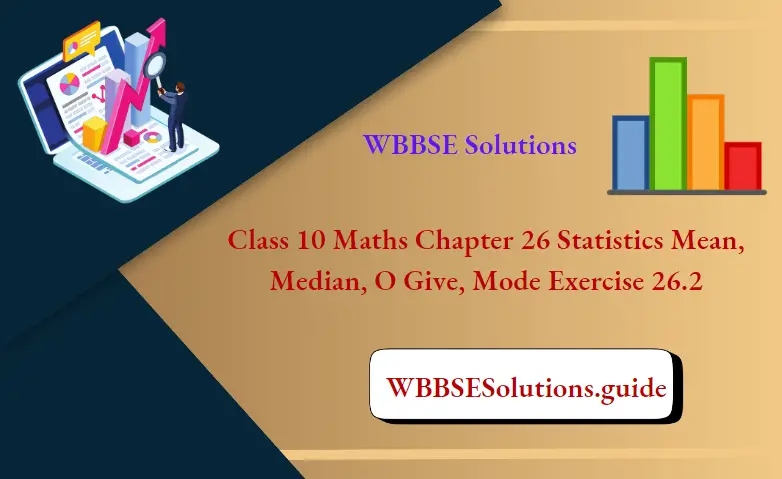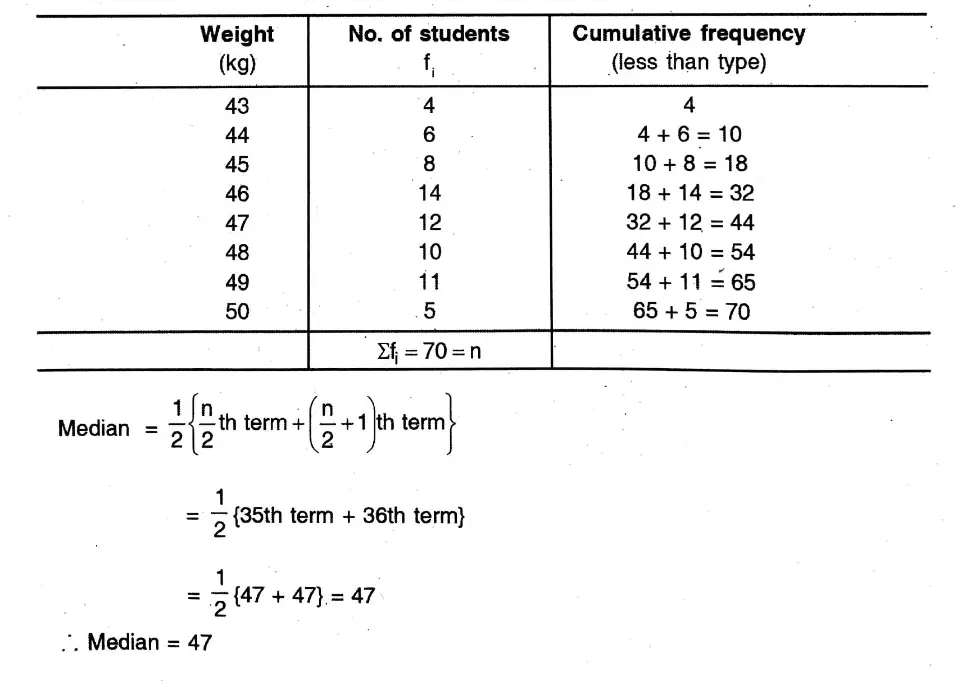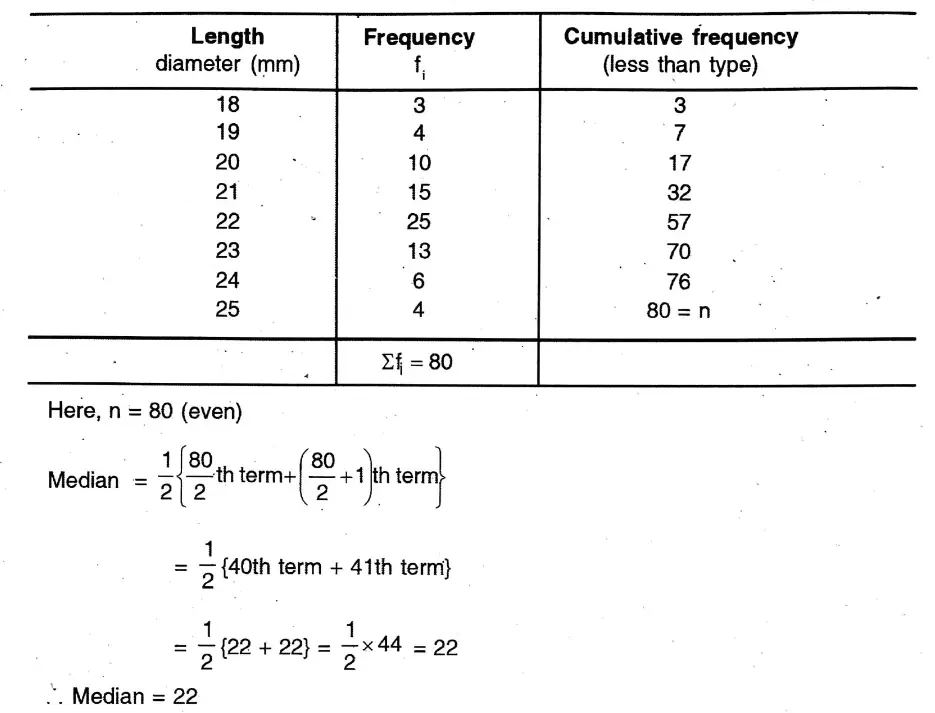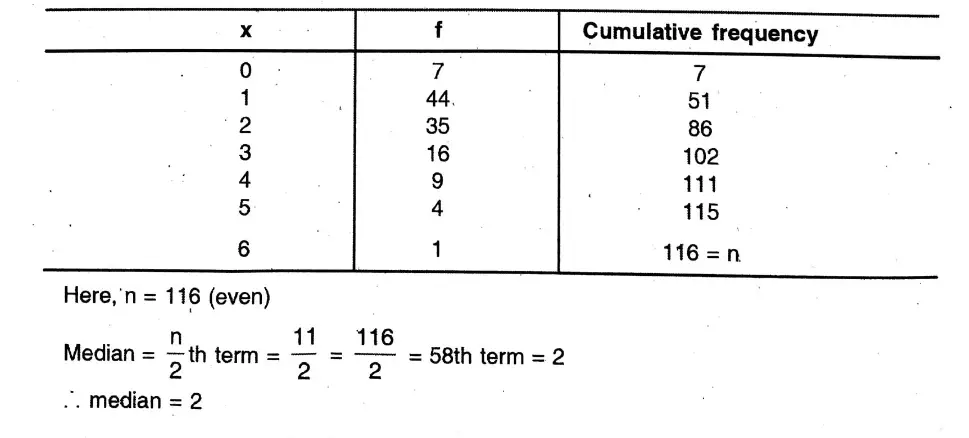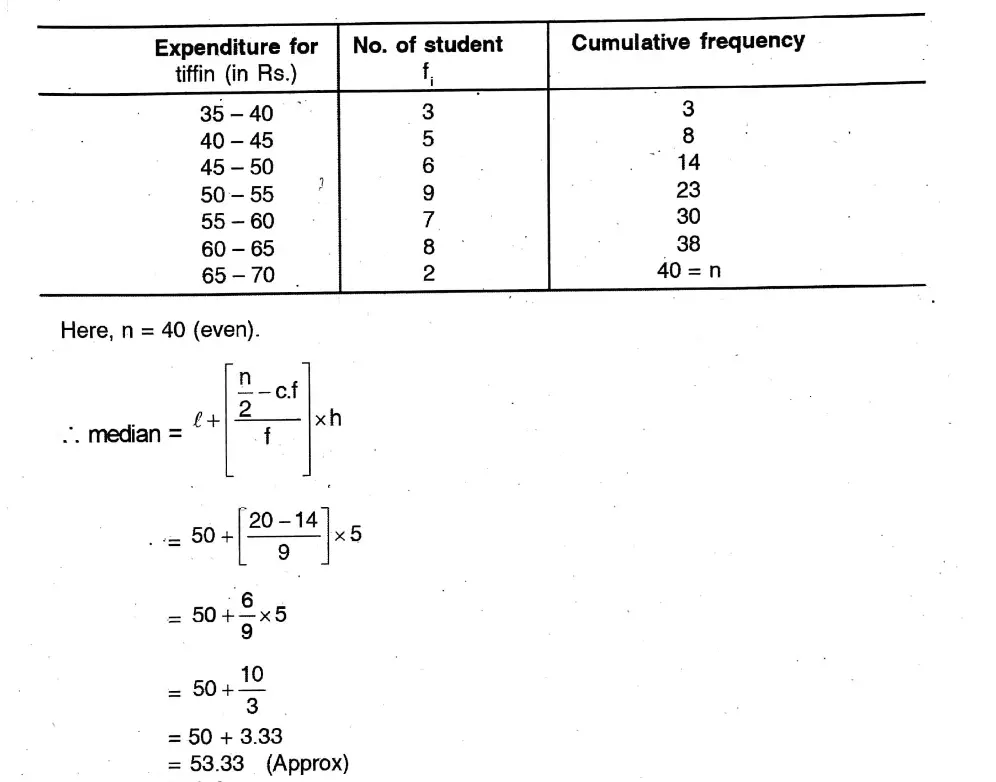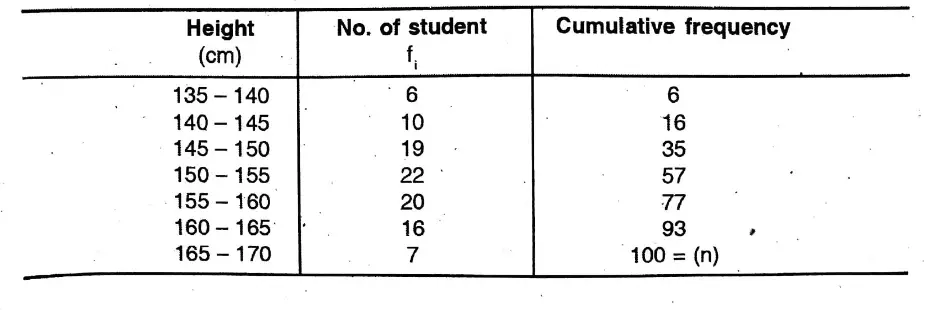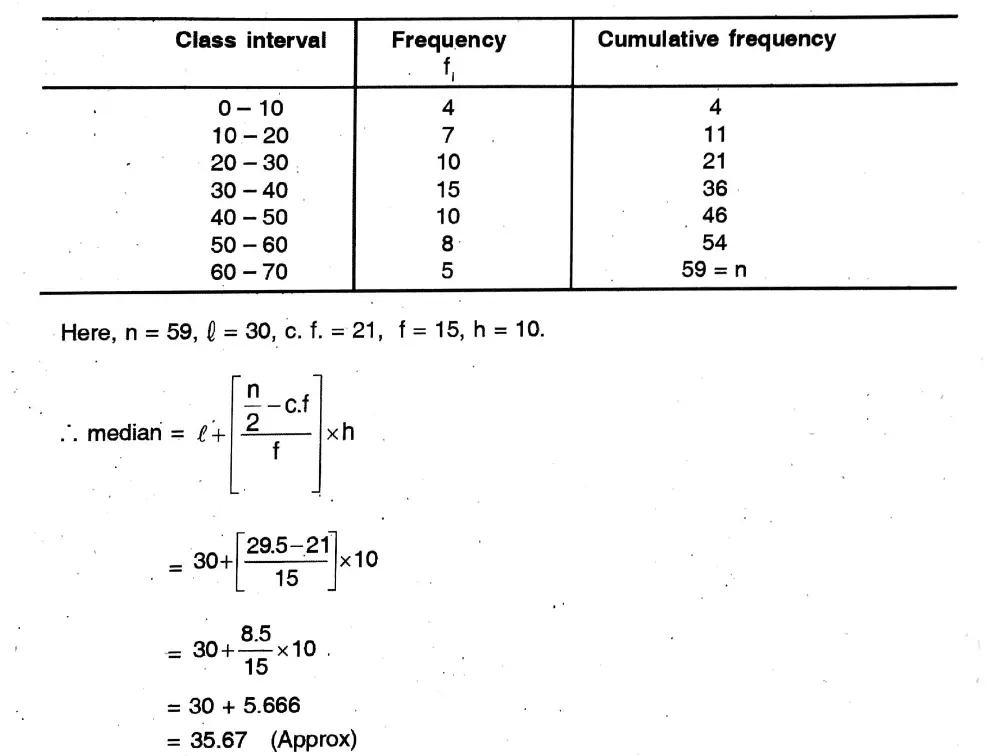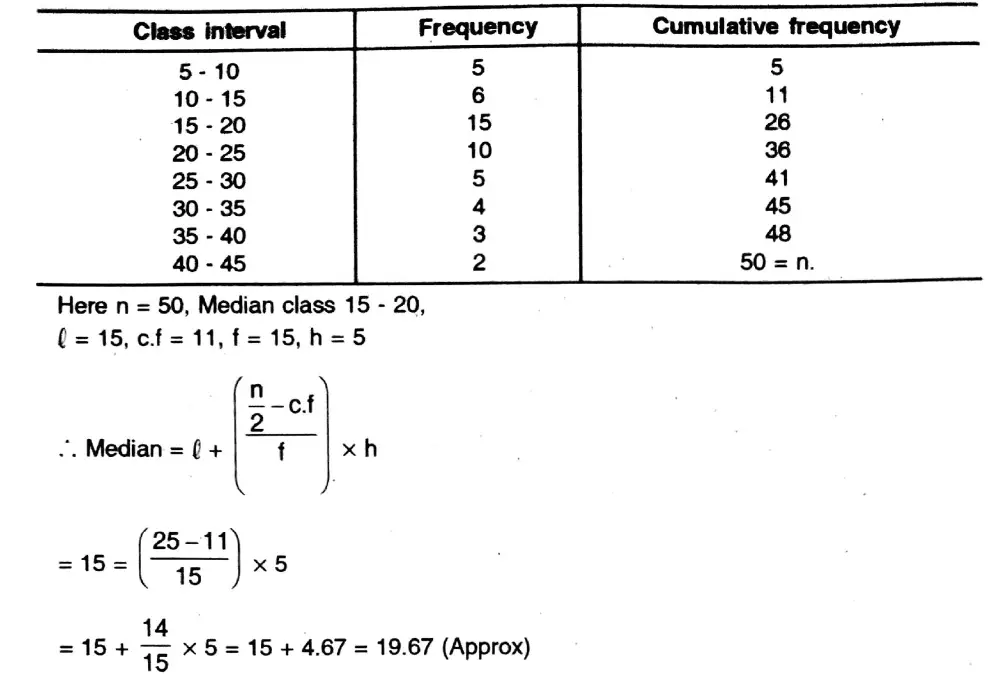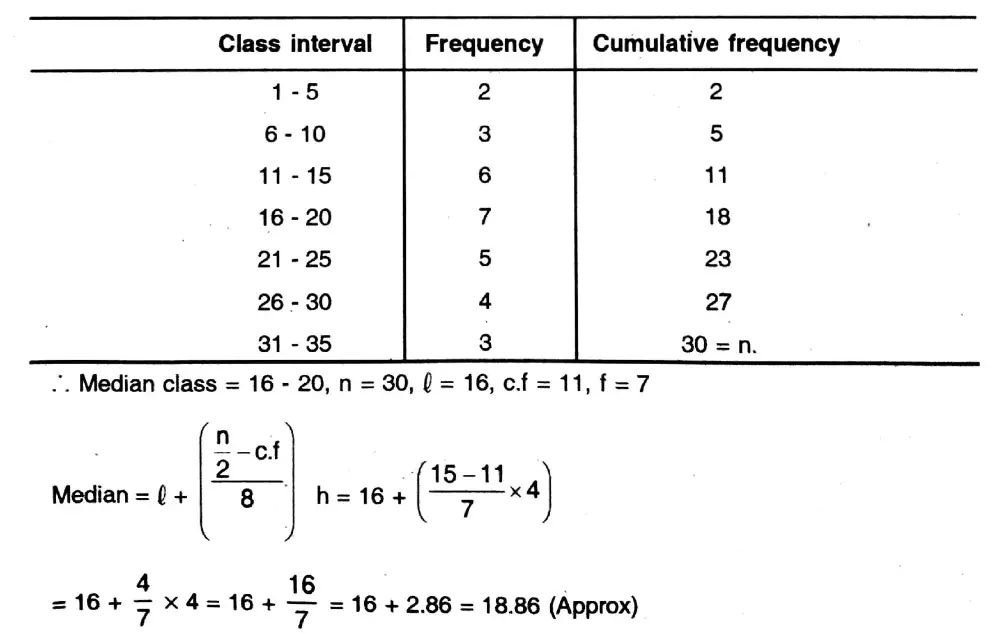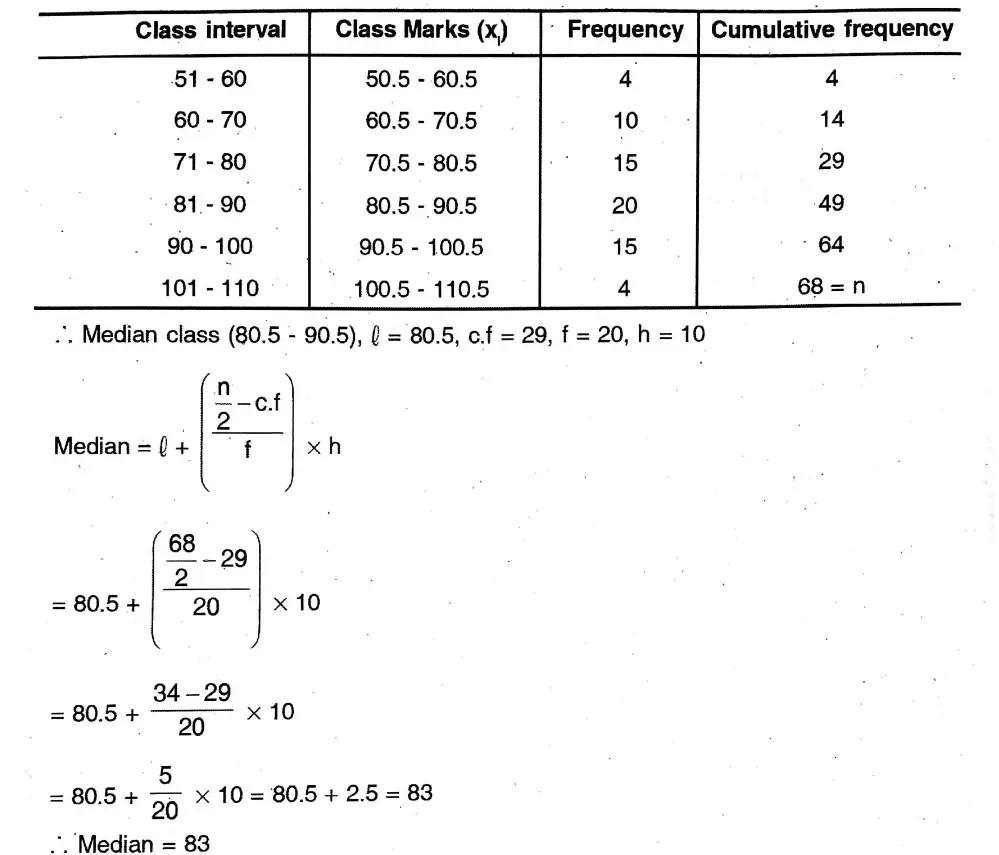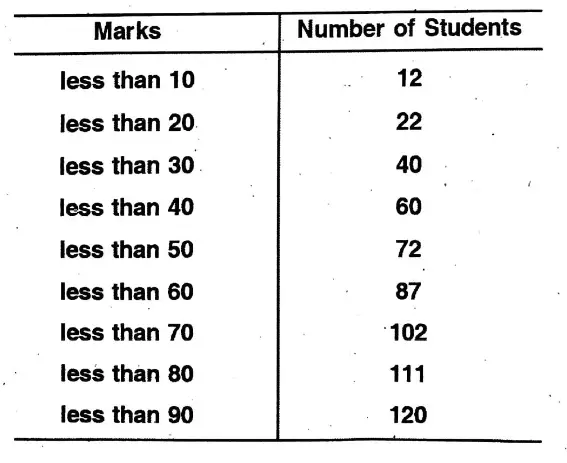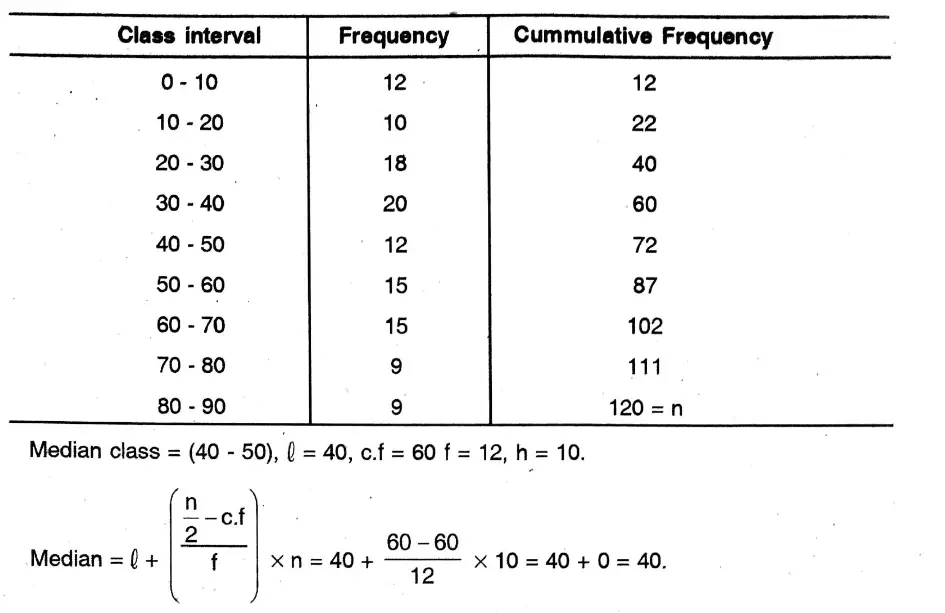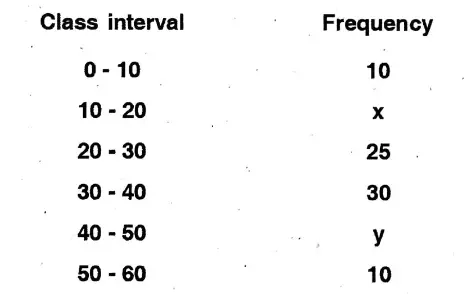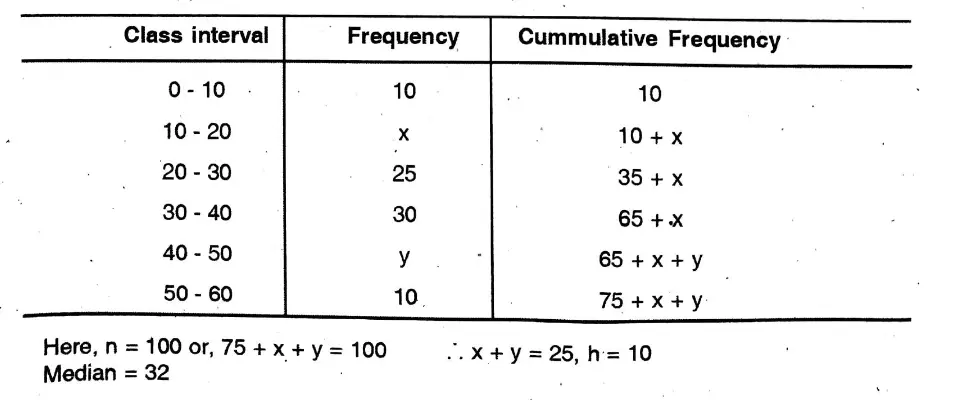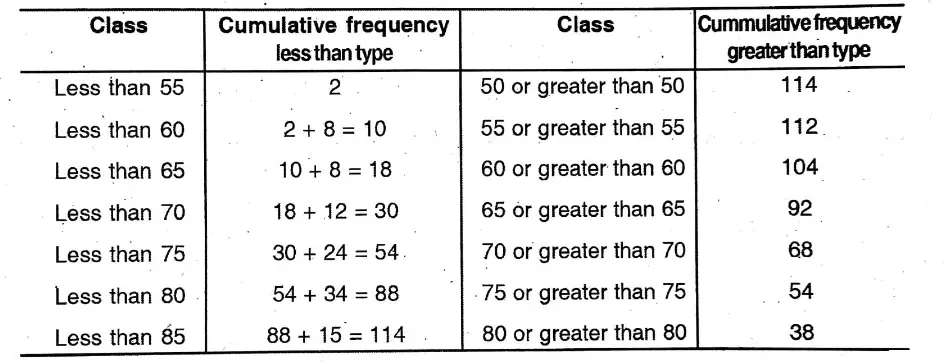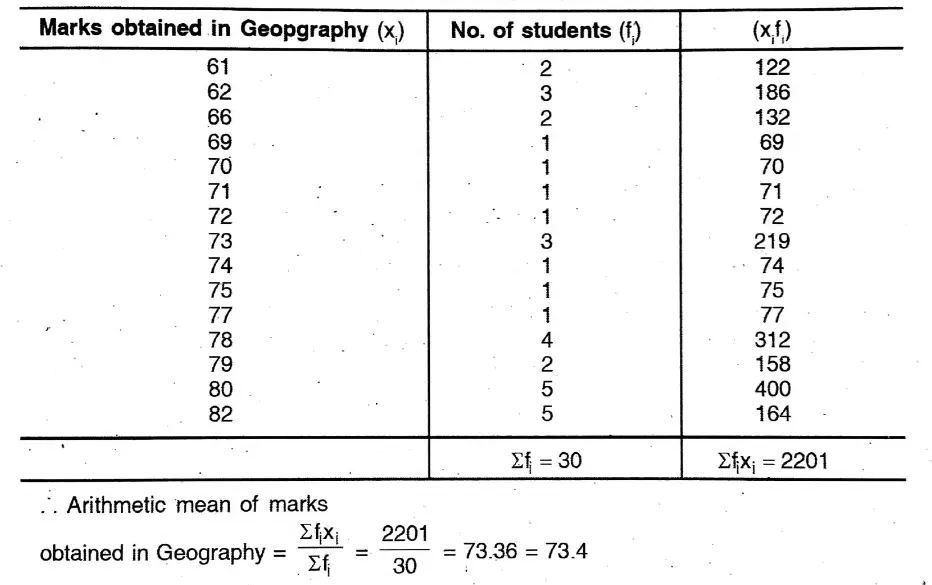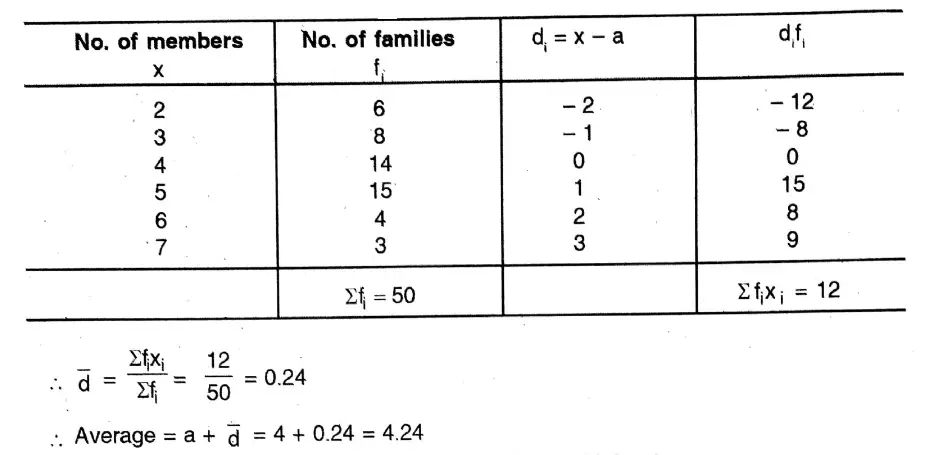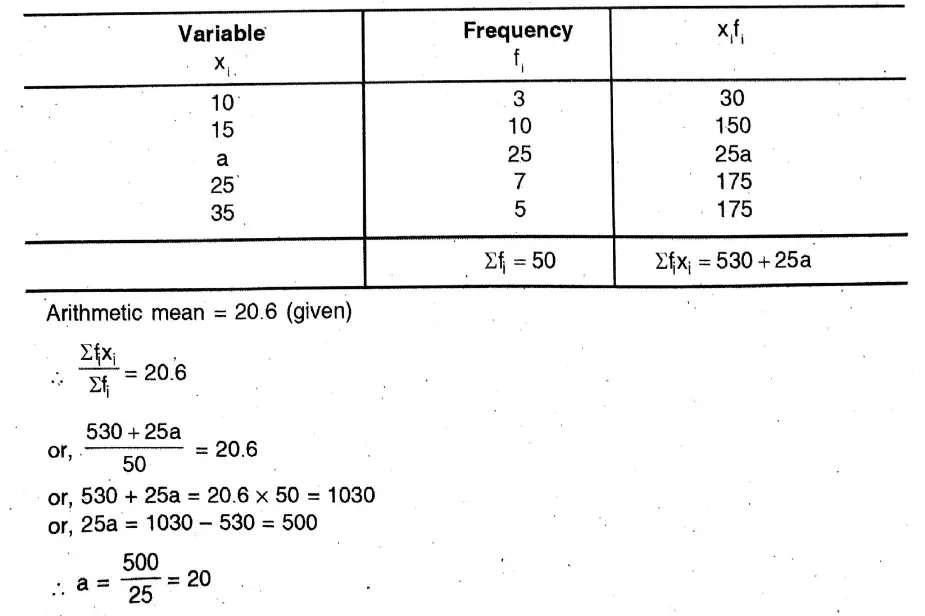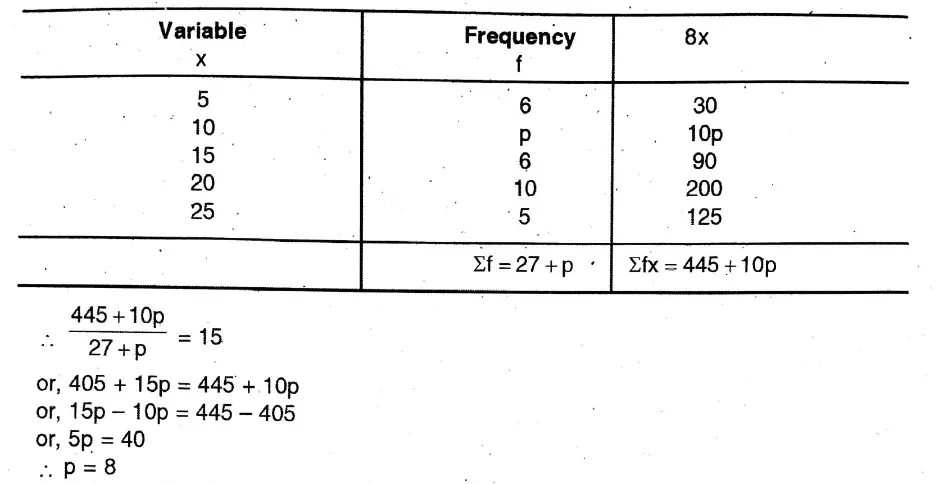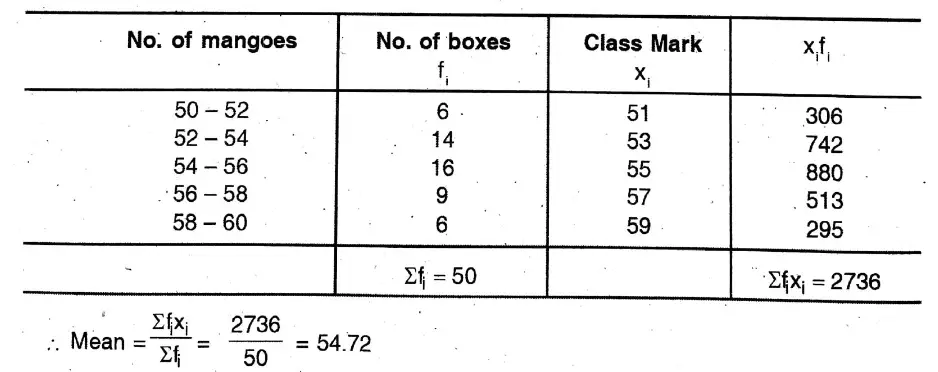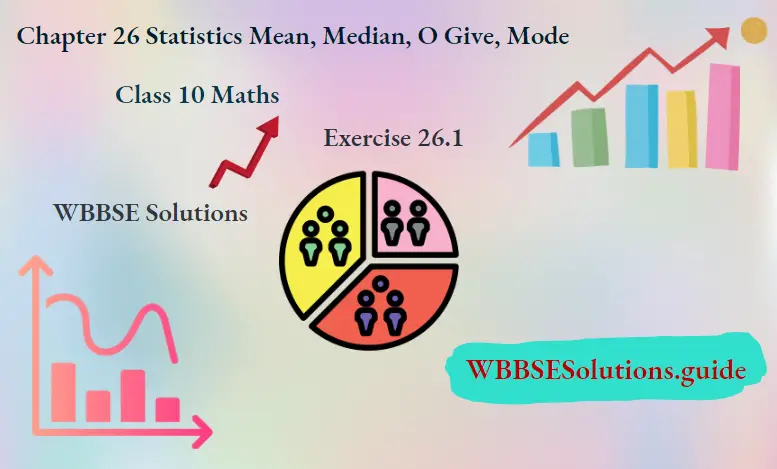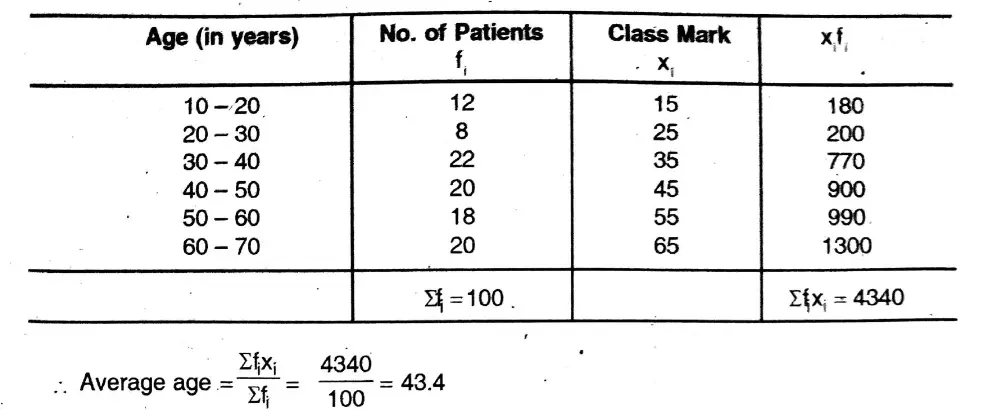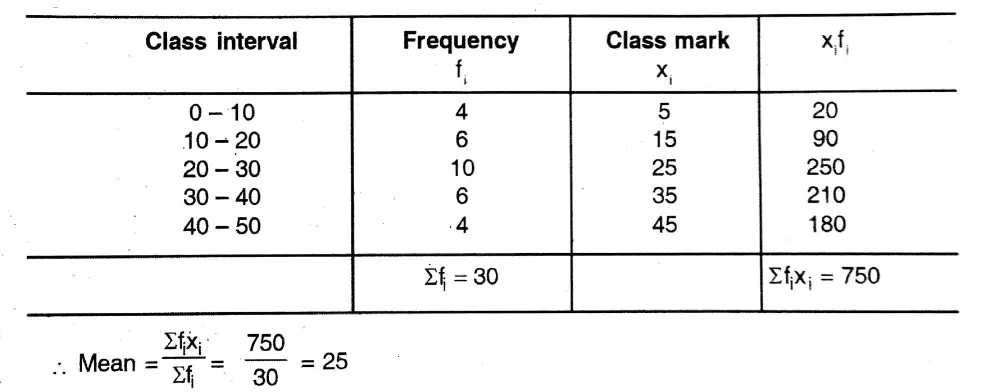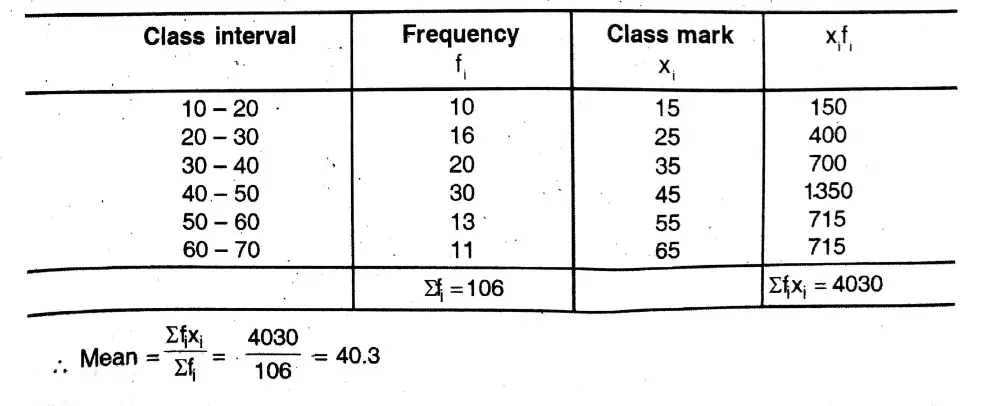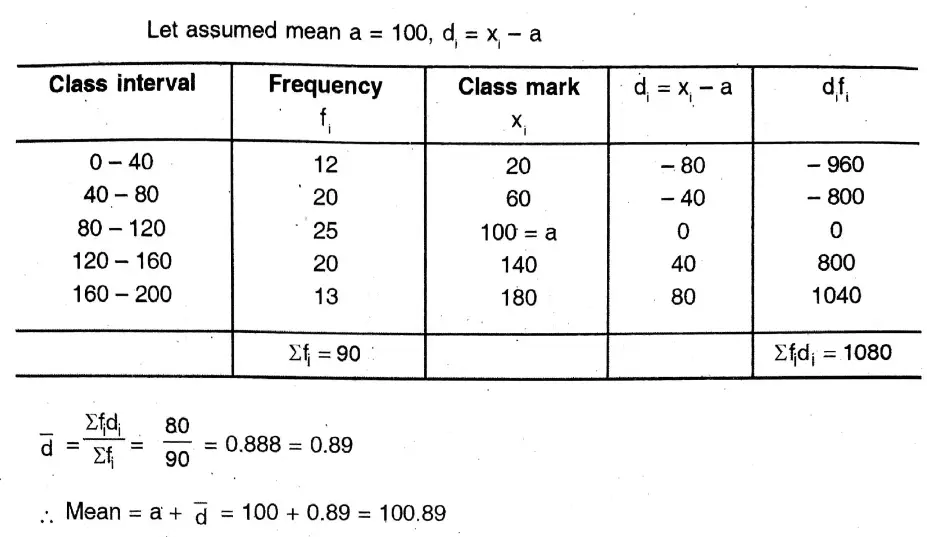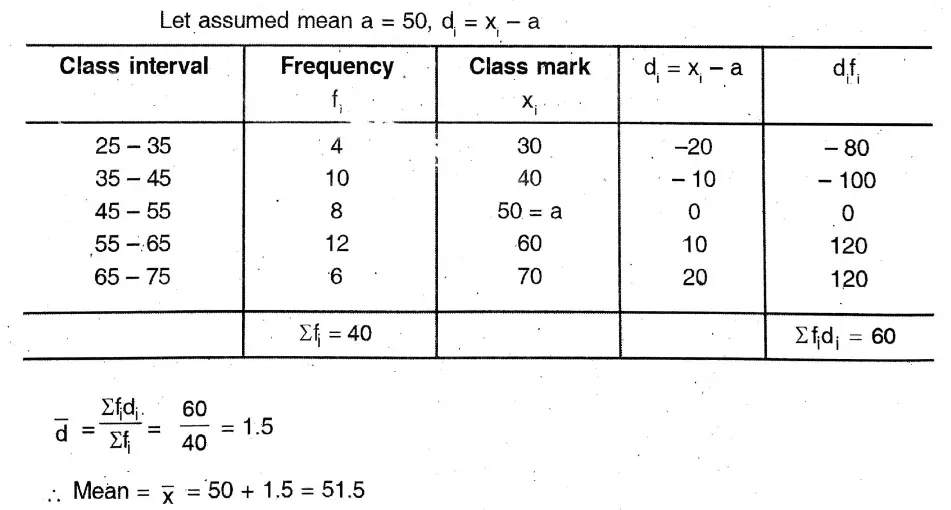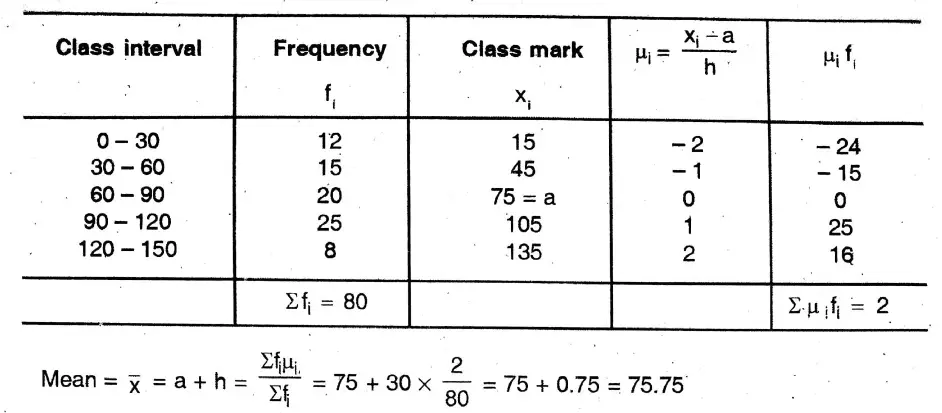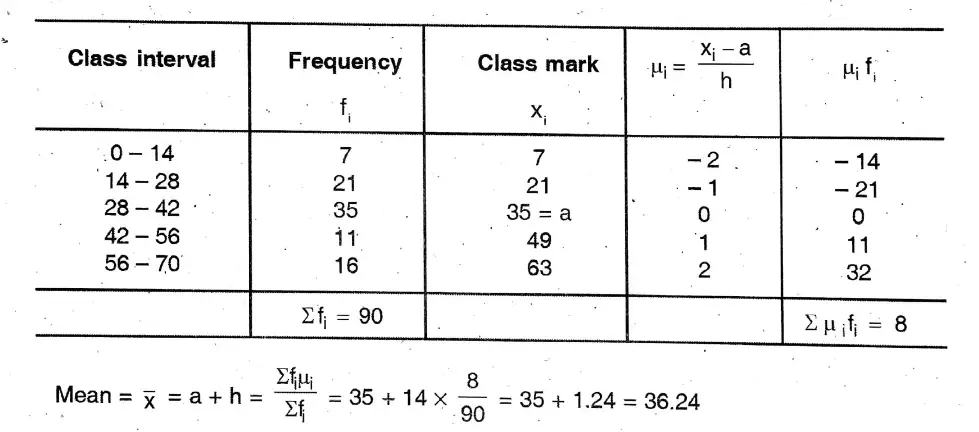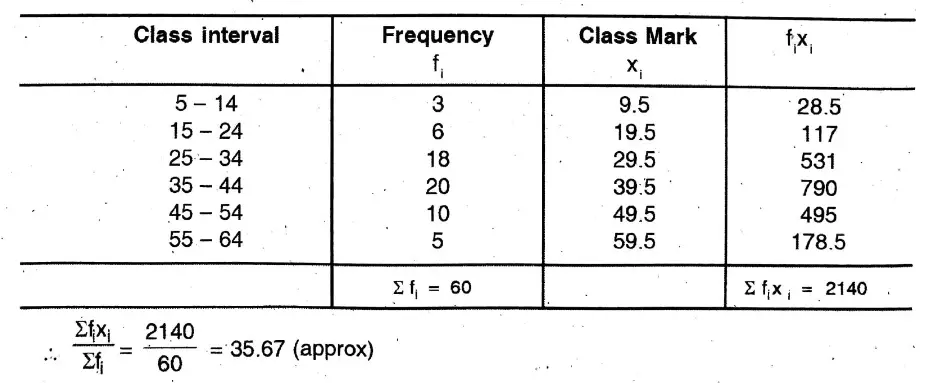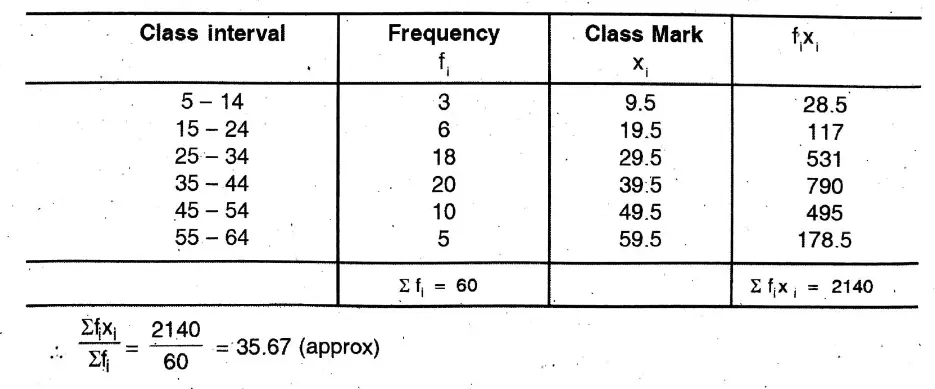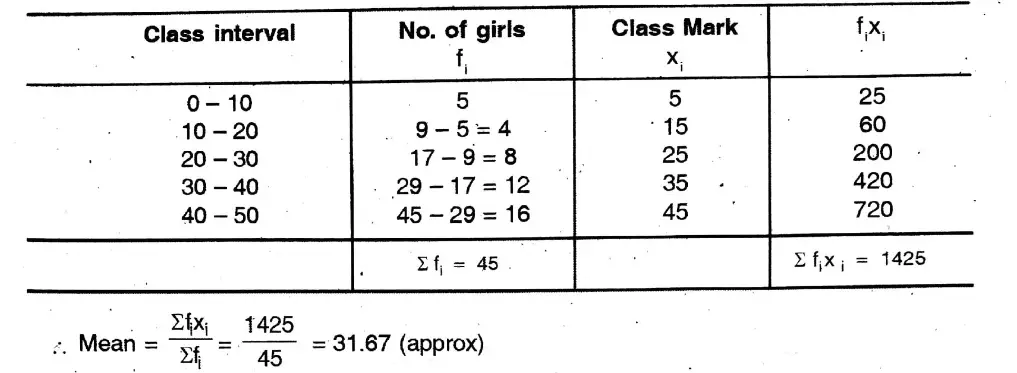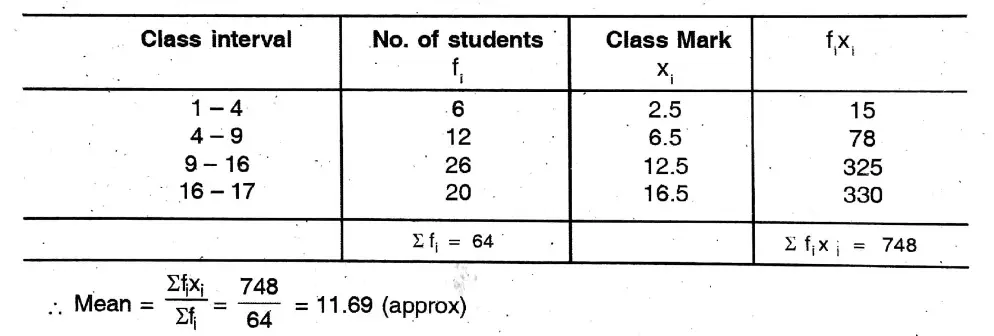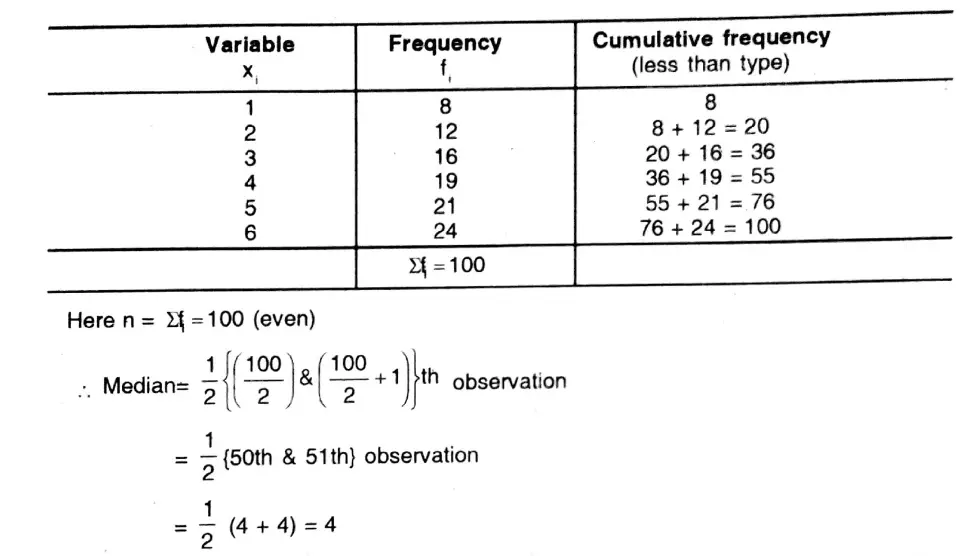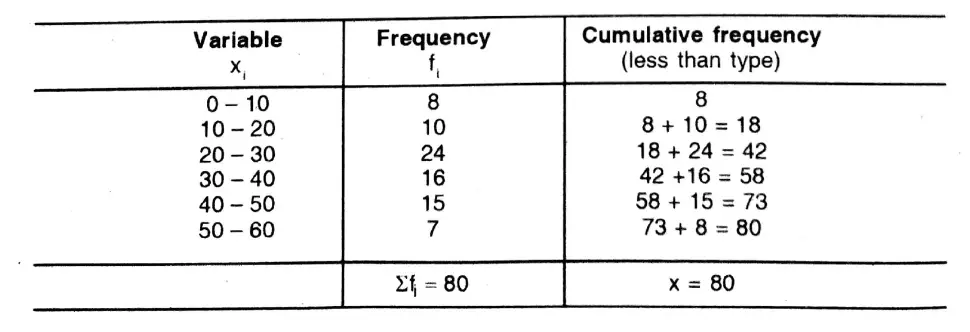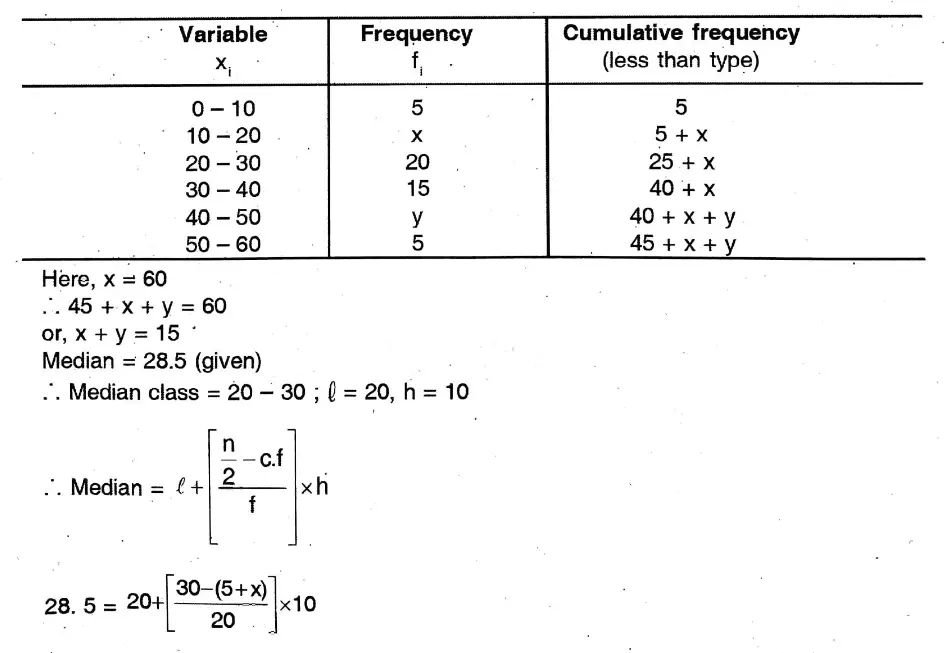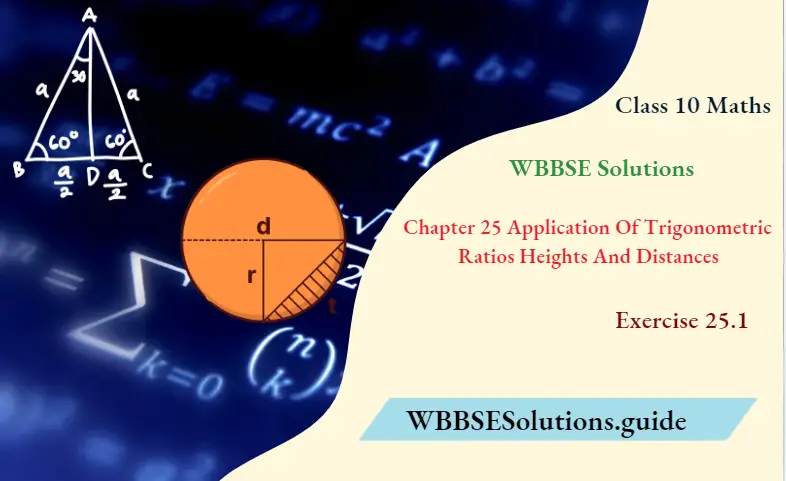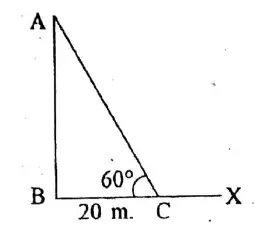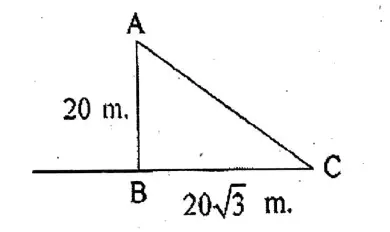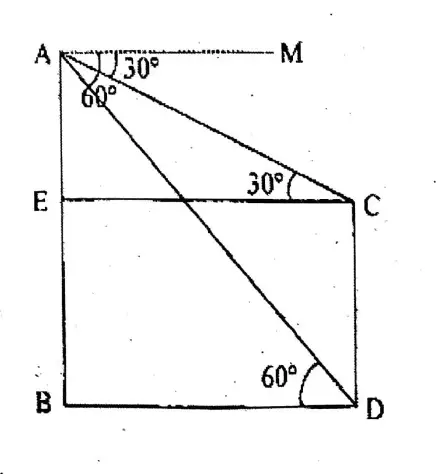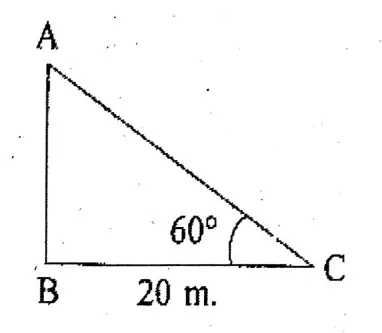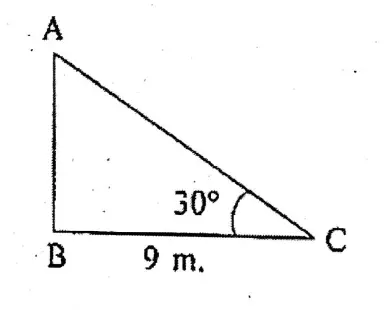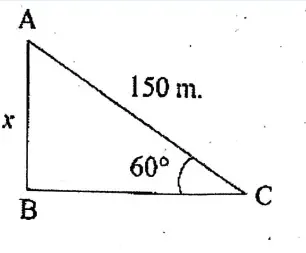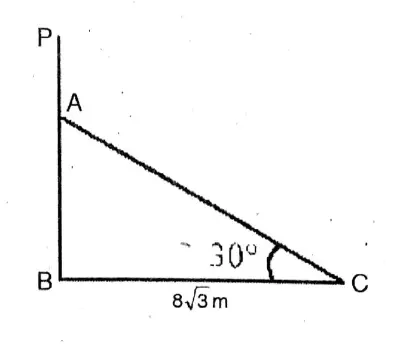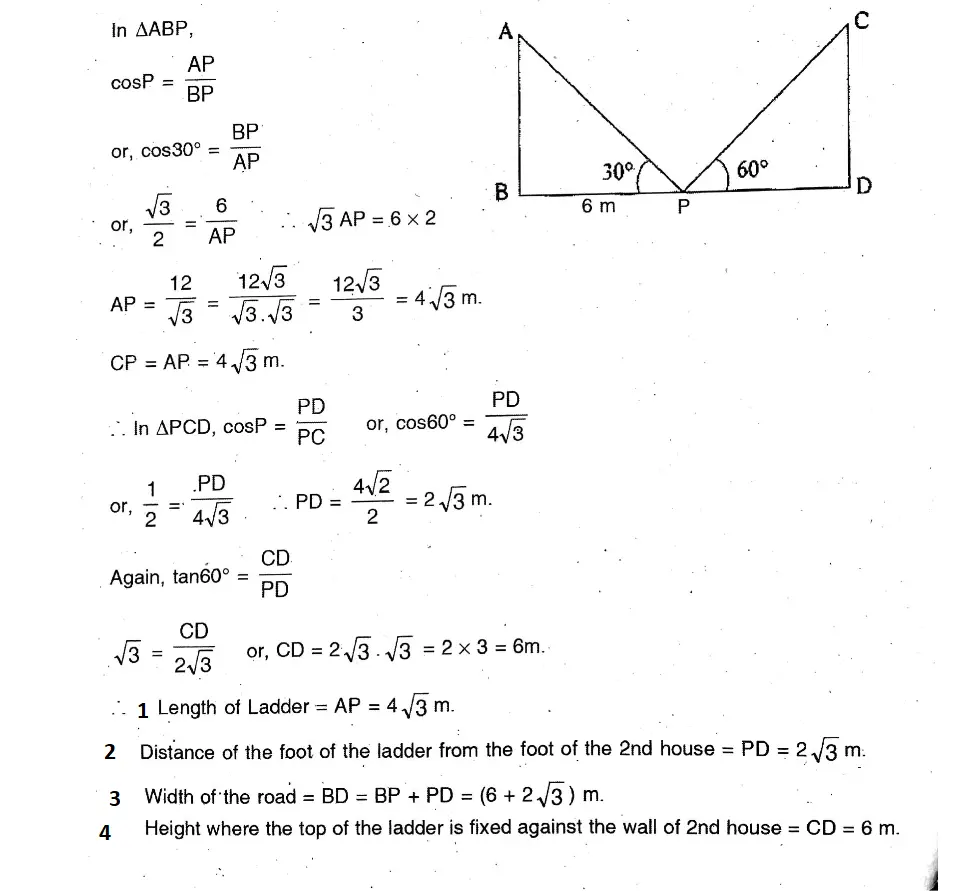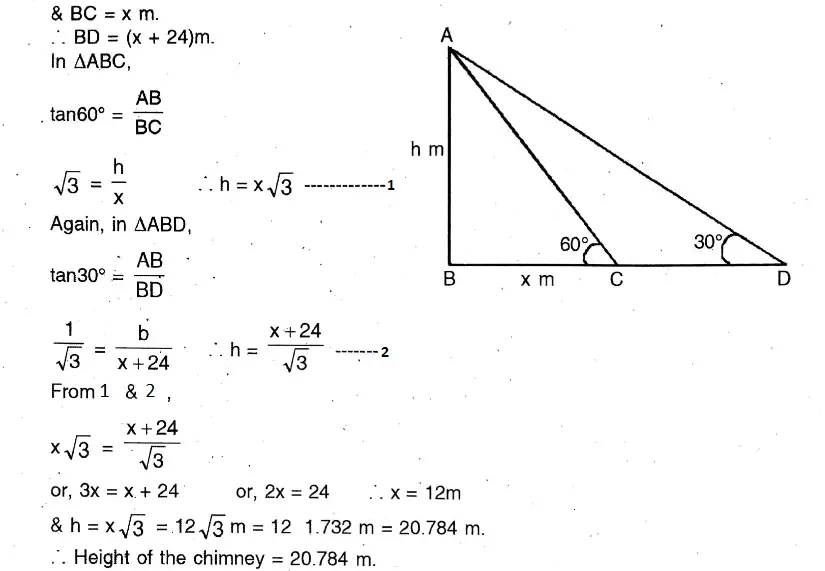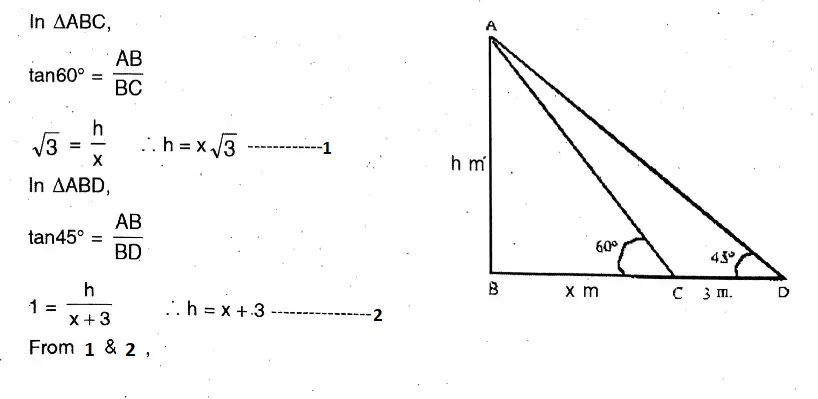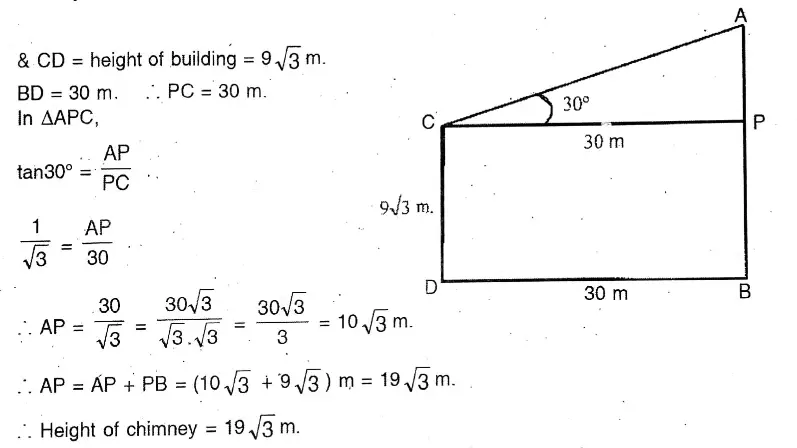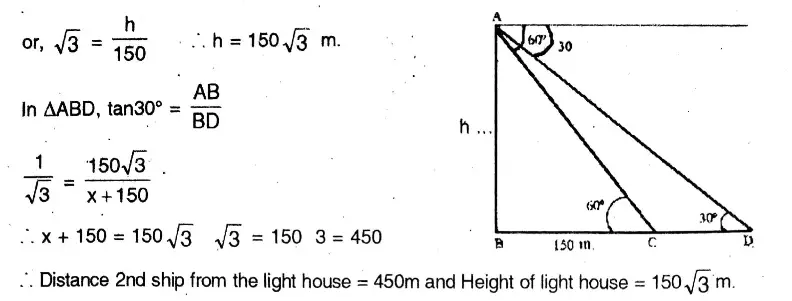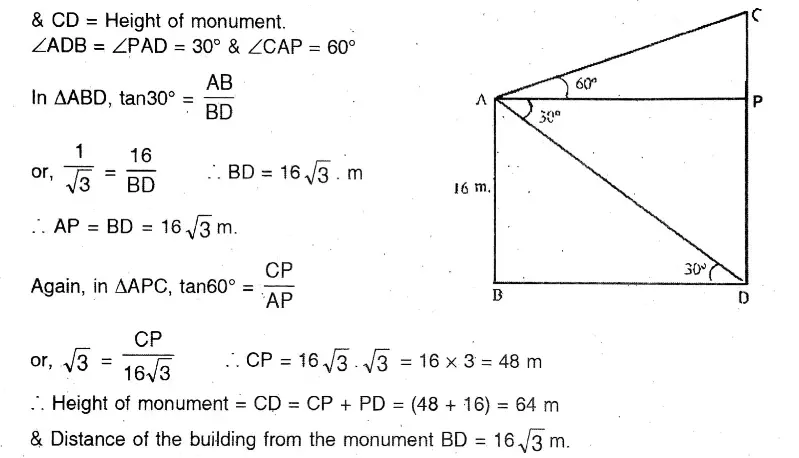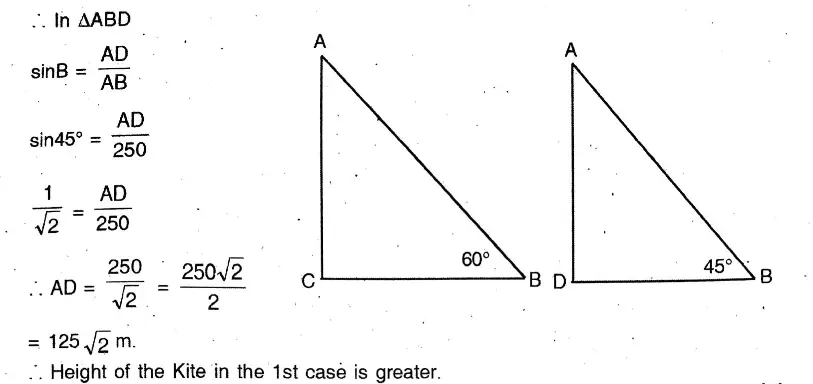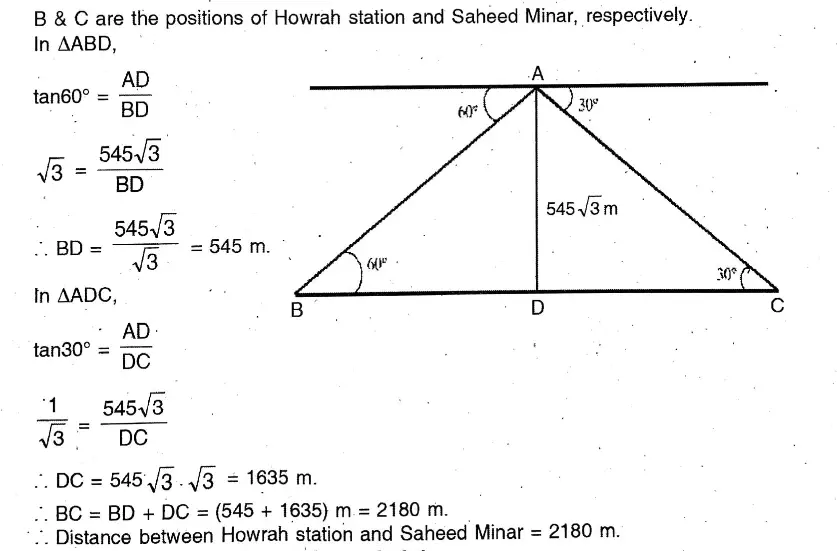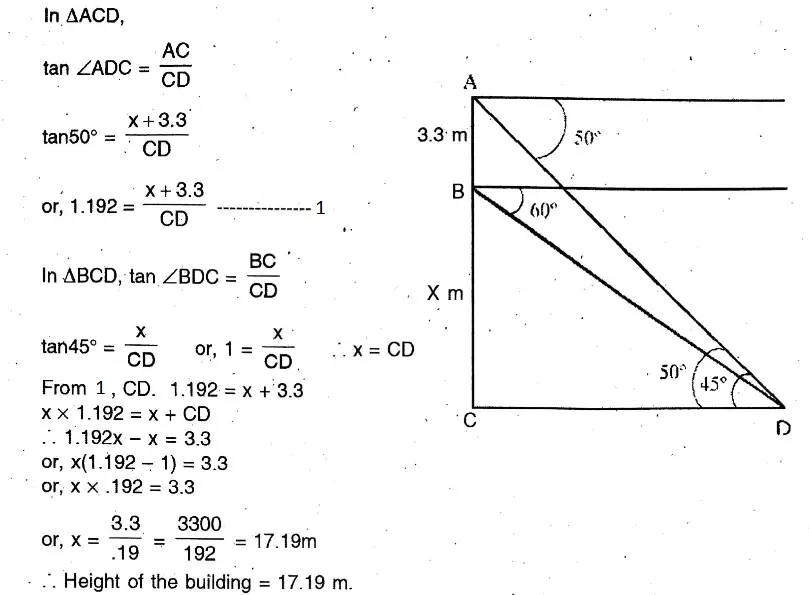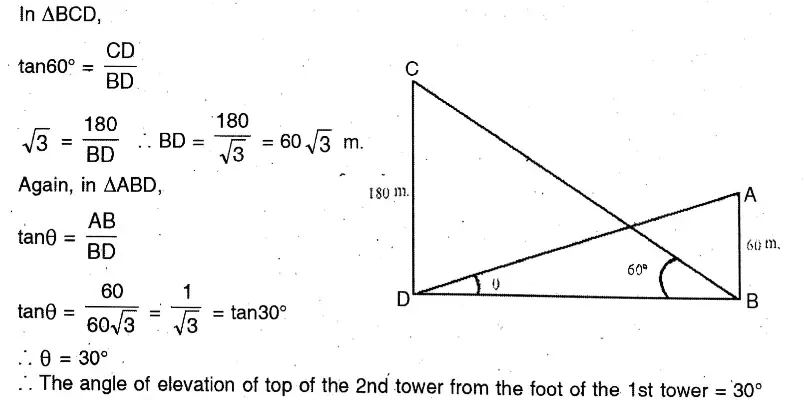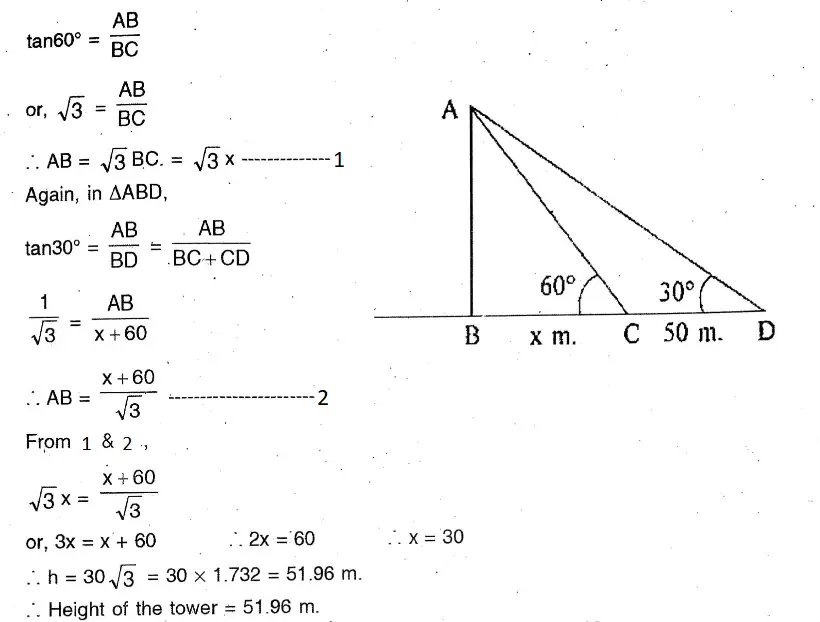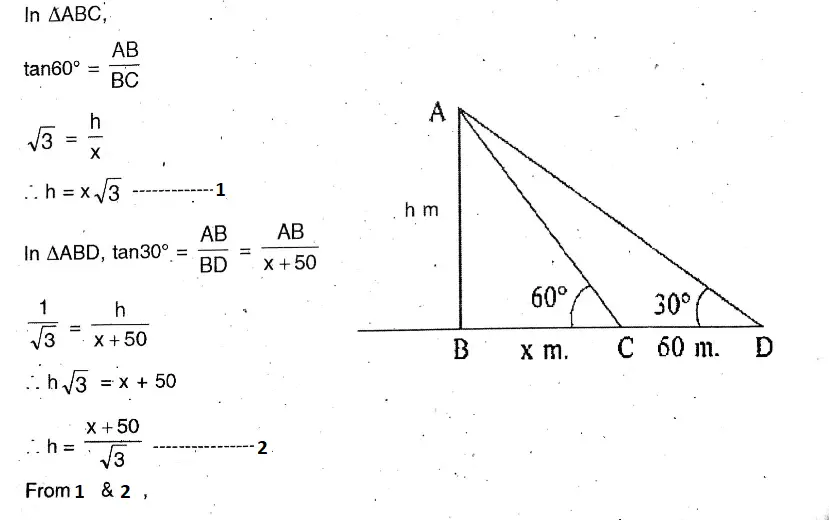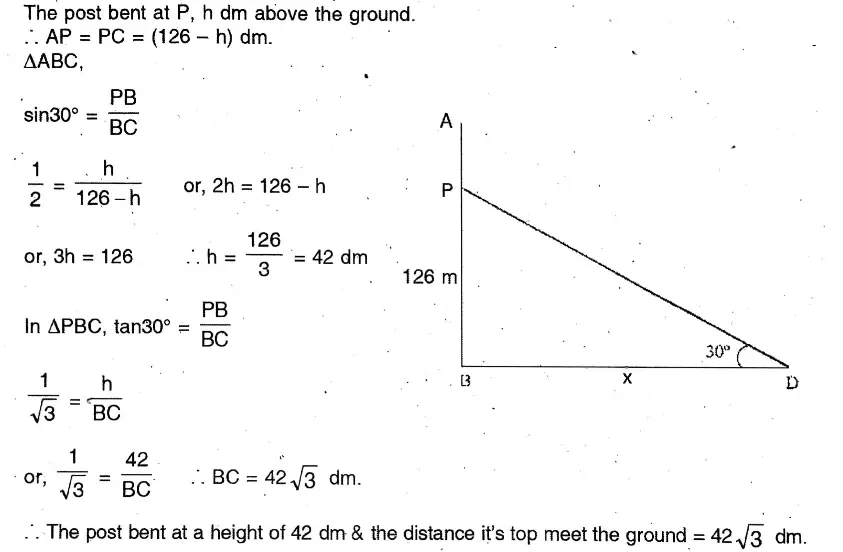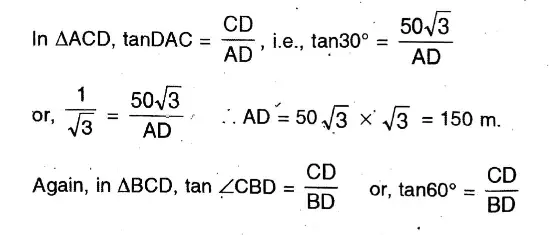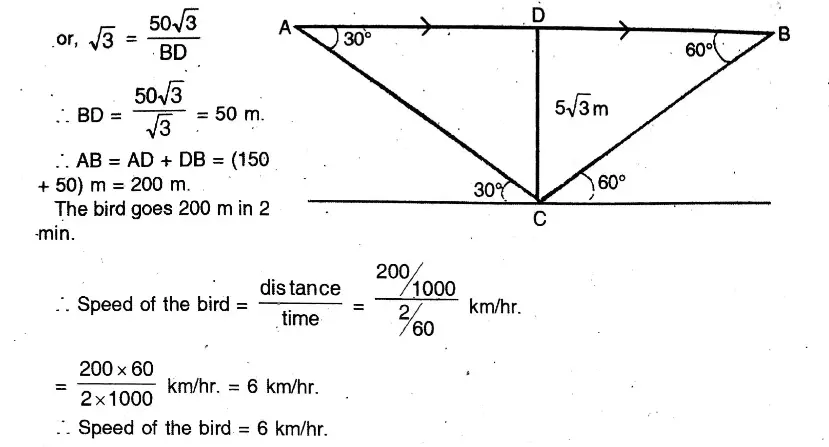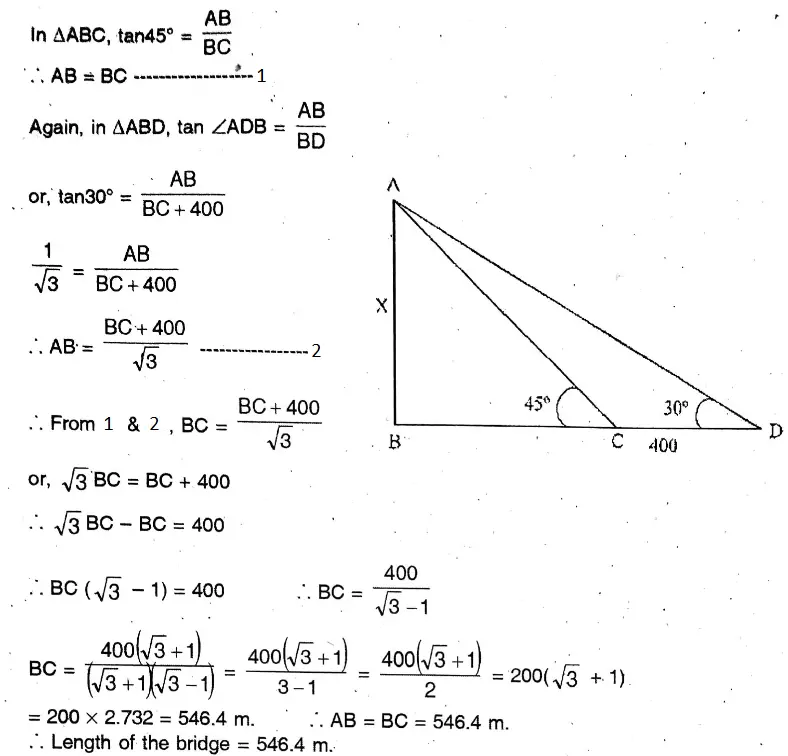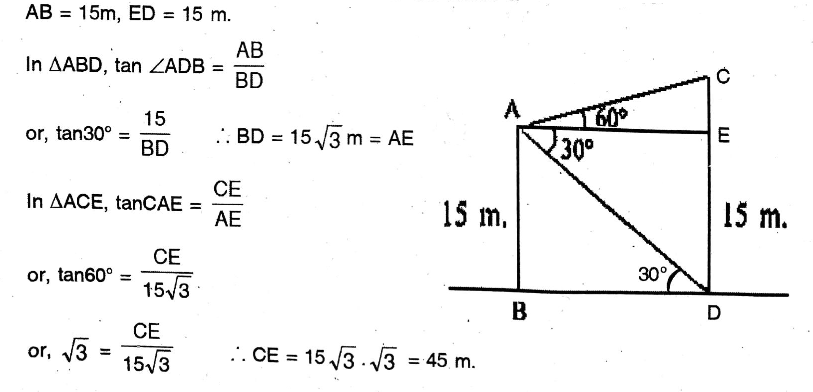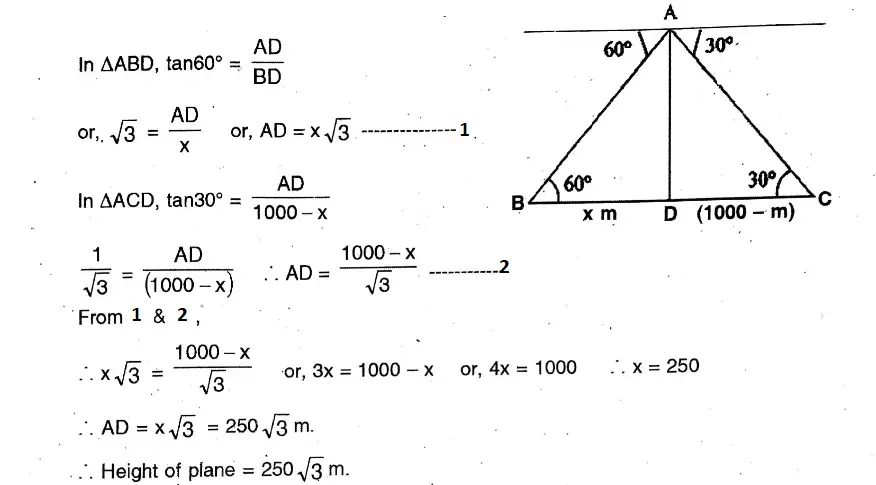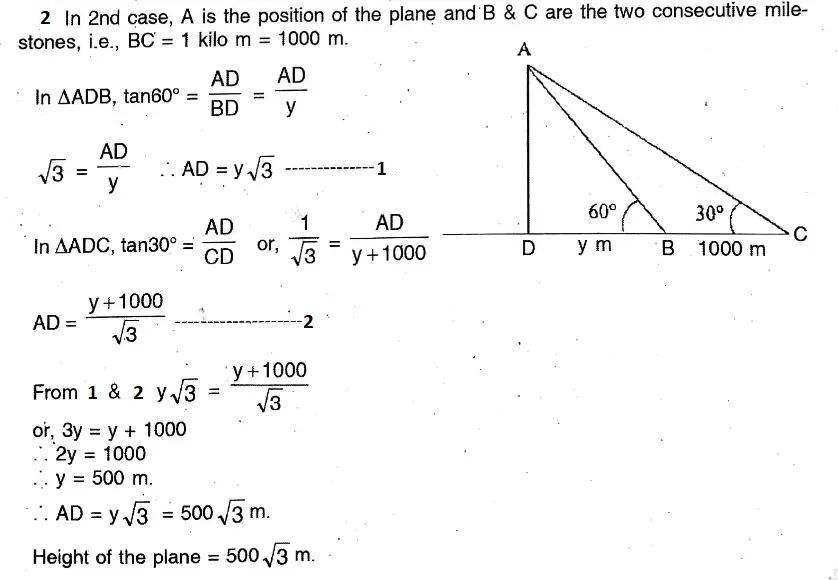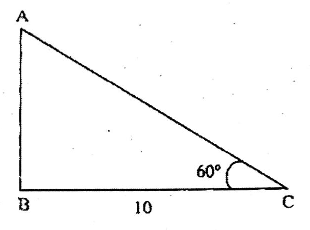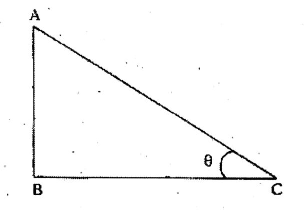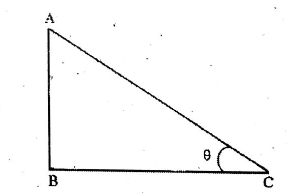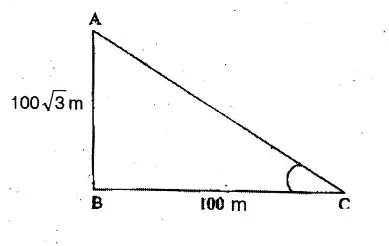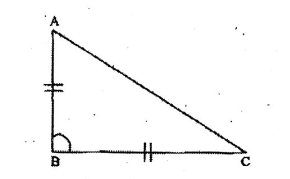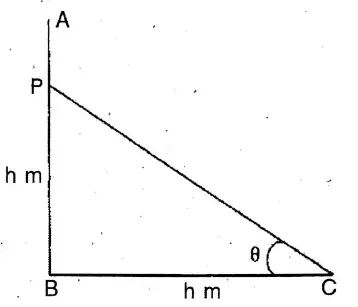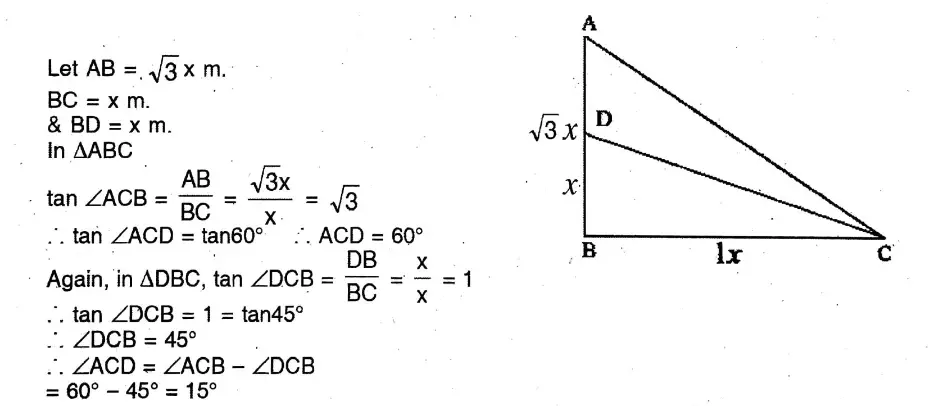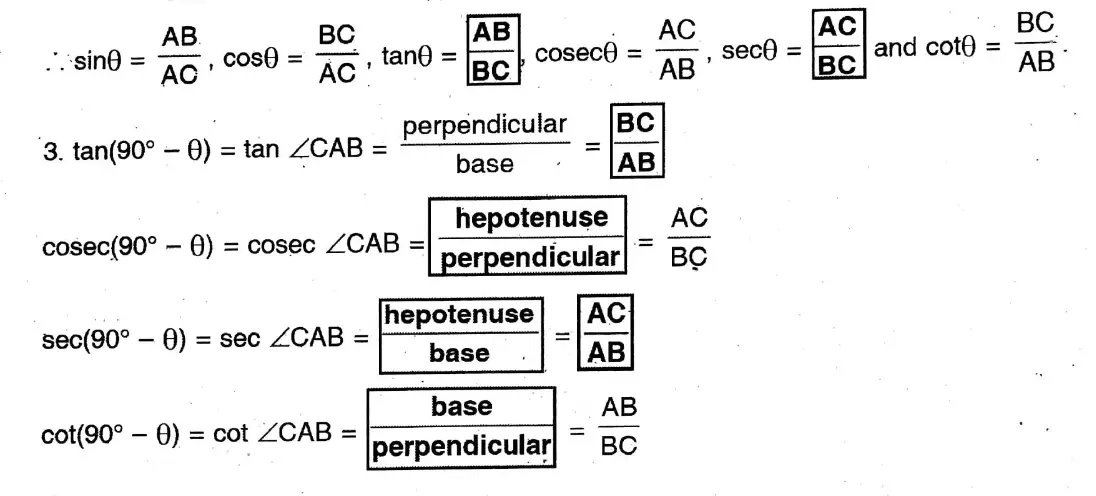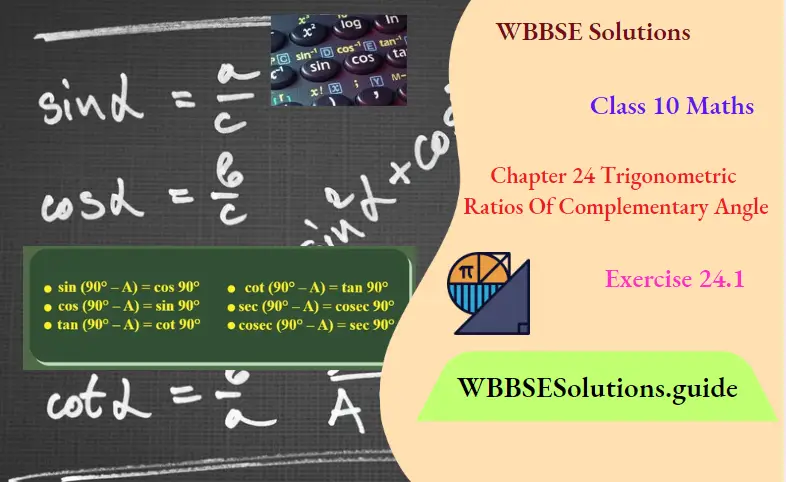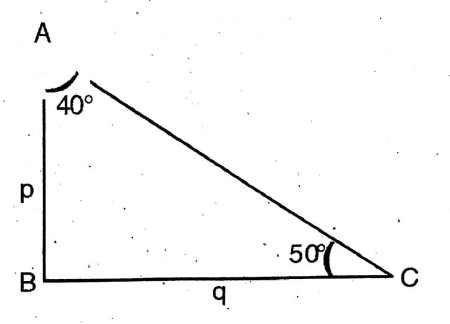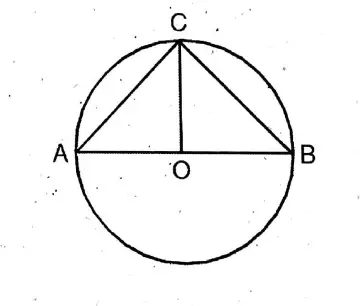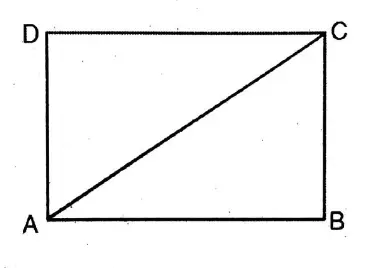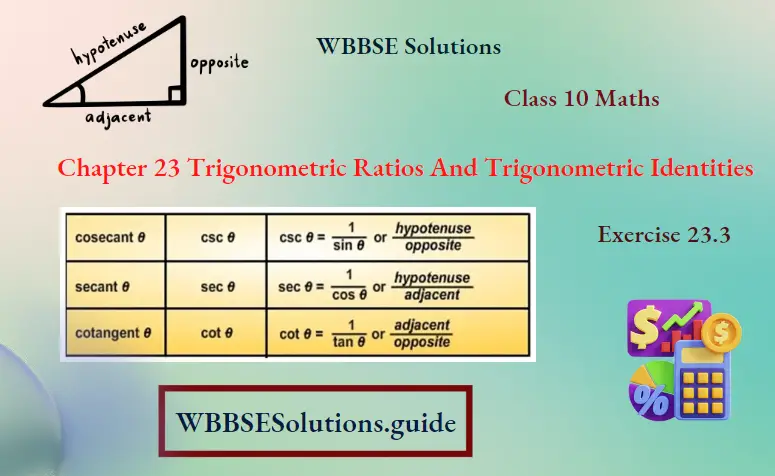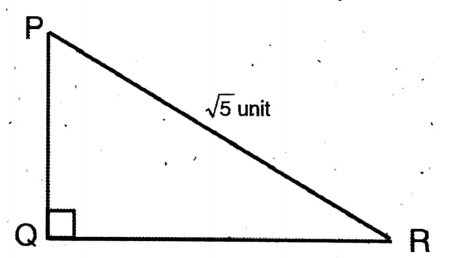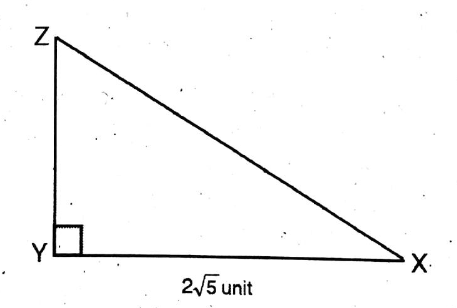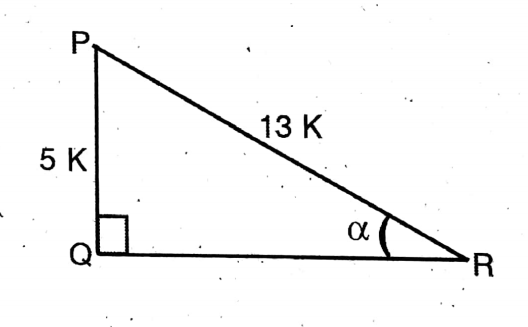Model Question Paper 2023 Mathematics set 3
Model Question Paper 2023 Mathematics set 3 MCQs
Question 1. Interest on principal amount Rs. b at the rate of simple interest a% per annum for C months is
1. Rs. abc/1200
2. Rs. abc/100
3. Rs. abc/200
4. Rs. abc/120
Solution: l = prh/100
= Rs. abc/12 / 100
= Rs. abc/1200
Answer. 1. Rs. abc/1200
Question 2. The ratio of the capital amounts in a joint business invested by Tirtha, Bulu, and Rabeya is 10:12: 15 if the profit at the end of the year is Rs. 7,400. Rabeya will get a share of the profit of
1. Rs. 2,000
2. Rs. 2,400
3. Rs. 3,000
4. Rs. 2,800
Solution:
The ratio of the capital amounts in a joint business invested by Tirtha, Bulu, and Rabeya is 10:12: 15 if the profit at the end of the year is Rs. 7,400.
Share of profit of Rabeya = 15/10+12+15
= 15/37 x Rs. 7,400
= 15/37 x Rs. 7,400
= Rs. 3,000
Answer. 3. Rs. 3,000
Question 3. If x ∝ y, then
1. x² ∝ y²
2. x³∝ y²
3. x∝ y3
4. x²∝ y²
Answer. 4. x² ∝ y²
Question 4. If the roots of quadratic equation kx²-5x+ k = 0 are real and equal, the value of k is
1. ± 5
2. ± 5/2
3. ± 2/5
4. ± 2
Solution: When roots are equal, discriminant = 0
i.e., (-5)²-4 K K = 0
∴ K²= 25/4
∴ K = ± 5/2
The value of k is ± 5/2
Answer: 2. ± 5/2
Question 5. If a/3 = b/4 = c/7 = 2a-3b+c / x
1. 1
2. 2
3. 3
4. 4
Solution: x = 2 x 3 – 3 x 4 +7
= 6-12+7
= 1
Question 6. If x = √7 + √6, the value of x + 1/x is
1. 2√6
2. √6
3. 2√7
4. √7
Solution: x = √7+√6
∴ 1/x = 1/√7+√6
= √7-√6
=2√7
Answer: 3. 2√7
Question 7. If α = 90°, B = 30°, the value of sin(α-B) is
1. 1
2. 1/2
3. √3/2
4. 1/√2
Solution: sin(α-B)=sin(90° – 30°) = sin60° = √3/2
Ans. 3. √3/2
Question 8. The angle measured 1 radian will be
1. acute angle
2. right angle
3. obtuse angle
4. straight angle
Answer. 1. acute angle
Question 9. In a cyclic quadrilateral ABCD if AB = AD and ∠ABD = 30°, the value of ∠BCD is
1. 90°
2. 30°.
3. 45°
4. 60°
Solution: ∠ADB = ∠ABD = 30°
∴ ∠BAD = 180° -2 (30°)
= 120°
∴ ∠BCD = 180° – 120°
= 60°
Answer. 4. 60°
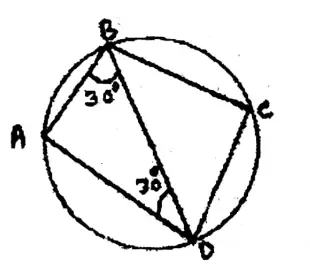
Question 10. The tangent PA is drawn to a circle with center O from the external point P. If PA = 4 cm OP = 5 cm. the radius of the circle is
1. 5 cm.
2. 4 cm.
3. 6 cm.
4. 8 cm.
Solution: OP² = OA² + AP²
The tangent PA is drawn to a circle with center O from the external point P. If PA = 4 cm OP = 5 cm
OA² = OP² – AP²
= 5²-4²=9
∴ OA = √9 = 3
∴ Diameter = 23cm = 6cm.
Answer. 3. 6 cm.
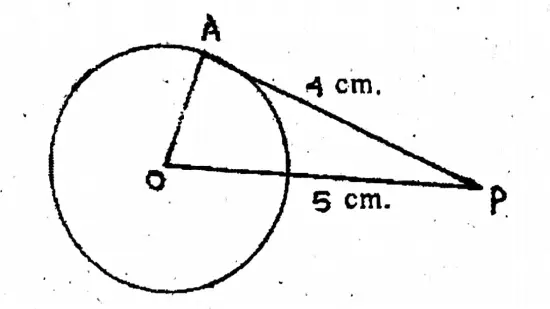
Question 11 If = AB/DE = BC/FD = AC/EF of ΔABC and ΔDEF,
1. ∠B = ∠E
2. ∠A = <D
3. ∠B = <D
4. ∠A = <F
Answer. 3. <B = <D
Question 12. If the ratio of volumes of two cubes is 8: 125, the ratio of total surface areas of the two cubes will be
1. 2:5
2. 4:25
3. 4:5
4. 2:25
Solution: Ratio of volumes of two cubes = 8: 125
∴ Ratio of sides =3√8/125
= 2/5
Ratio of surface areas = (2/5)²
= 4:25
Answer. 2. 4: 25
Question 13. If the length of the radius of the base of a right circular cone remains the same, the height becomes half of the previous one, then the volume of the cone will be decreased by
1. 25%
2. 50%
3. 75%
4. 100%
Answer. 2. 50%
Question 14. The mode of 1, 3, 2, 8, 10, 8, 3, 2, 8, 8 is
1. 2
2. 3
3. 8
4. 10
Solution: By arranging 1, 2, 2, 3, 3, 8, 8, 8, 8, 10
Answer. 3. 8
Question 15 The median of 8, 15, 10, 11, 7, 9, 11, 13, and 16 is
1. 15
2. 10
3. 11.5
4. 11
Solution: By arranging: 7, 8, 9, 10, 11, 11, 13, 15, 16
n = 9, Median = 9+1/2
= 5th term = 11
Answer. 4. 11
Question 2.
1. If a sum of money at 5% compound interest per annum for 2 years becomes Rs. 615, find the principal amount.
Solution:
If a sum of money at 5% compound interest per annum for 2 years becomes Rs. 615
A = P (1+r/100)n
∴ C.I = A-P = P (1+r/100)n – P
= P x 2.05 x 0.05
= 615
P = 615/2.05 x 0.05
= 6000
2. x and y are two variables. Corresponding values related to them are: x=7, y = 9; x = 4, y = 6; x = 12, y = 18; x = 3.6, y = 5.4. Determine the relationship of variation between x and y with reasons.
Solution:
x and y are two variables. Corresponding values related to them are: x=7, y = 9; x = 4, y = 6; x = 12, y = 18; x = 3.6, y = 5.4.
1st case x/y = 112/18 = 2/3
= x/y constant
∴ x α y
3. If the two roots of the quadratic equation x² + 8x + 2 = 0 are α and ẞ, find the value of (1/α + 1/β)
Solution: Here, α+β=-8 & α ẞ=2
1/α 1/β = α+β/αβ
= -8/2
= -4
4. A cylinder and a sphere are of equal radii, and their volumes are also equal. Find out the ratio of the diameter and height of the cylinder.
Solution: Volume of cylinder = 4r³h
Volume of sphere = 4/3 лr³
∴ 3h 4r or, 3h = 2 x 2r.
∴ 2r/h = 3/2
∴ Ratio of diameters: height = 3:2.
5. If the volume of a solid hemisphere is 144л, what is its diameter?
Solution : 2/3лr³ = 144π
r³ = 144 x 3 / 2
= 216
∴ r = 3√216 = 6.
Diameter = 2 x 6 cm = 12 cm.
True Or False
1. Only one circle can be drawn through three non-collinear points.
Answer: True
2. A concyclic parallelogram is a rectangular figure.
Answer: False
Fill In The Blanks
1. The angle in the segment of a circle that is greater than a semi-circle is A cute angle.
2. Perpendicular bisector of any chord passes through the Centre of the circle.
8. If tan2θ = 1, find the value of cos2θ.
tanθ = 1/tan2θ = cot2θ tan(90-2θ)
∴ θ=90-2θ or, 3θ = 90° ∴ θ = 30°
∴ cos2θ = cos60° = 1/2
9. The length of the radius of a circle is 14 cm. Find the circular measures of the angle at the center by an arc of this circle 66 cm in length.
Solution: Radian = arc/radian
= 66/15 radius
= 4.71 radians.
10.

Solution:
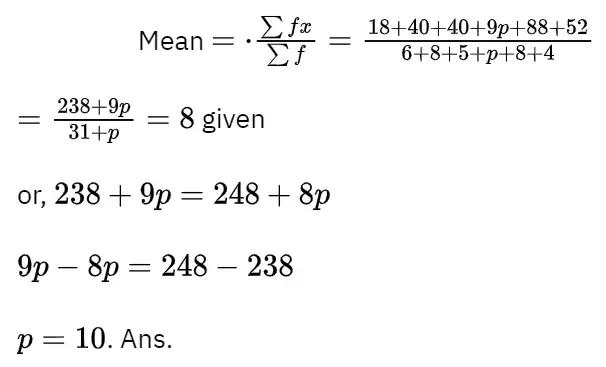
Question 3. At what rate of interest will Rs. 60,000 amount to Rs. 69,984 for 2 years?
Solution:
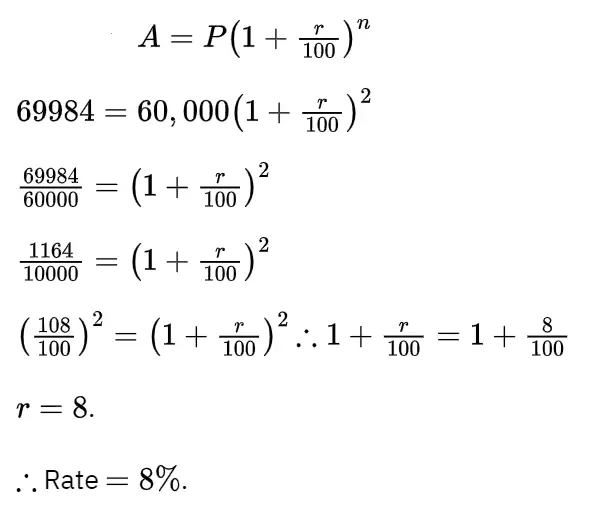
Or, At the start of the year, Arun and Ajoy started a business jointly with a capital of Rs. 24,000 and Rs. 30,000 respectively. After some months Arup Invested Rs. 12,000 more in that business. If the profit after the end of the year was Rs. 14030 and Arun got a profit share of Rs. 7130, determine after how many months Arun Invested the amount.
Solution:
At the start of the year, Arun and Ajoy started a business jointly with a capital of Rs. 24,000 and Rs. 30,000 respectively. After some months Arup Invested Rs. 12,000 more in that business. If the profit after the end of the year was Rs. 14030 and Arun got a profit share of Rs. 7130
Let Arun invest Rs. 12,000 more after x months.
Arun’s Capital throughout the year
= Rs. [24000 × 12+12000 x (12-x)]
= Rs. (288000 + 144000 12000x)
= Rs. (432000 – 12000x)
ajoy’s Capital throughout the year
= Rs. 30000 x 12 = Rs. 360000
The ratio of Arun’s Capital & ajoy’s Capital
= (432000-12000x): 360000
= 1000(432-12x): 360000
= (432 – 12x): 360 12(36-x): 360 (36 – x): 30
Total profit= Rs. 14030.
∴Arun’s share of profit = 36-x / (36-x)+30 x Rs. 14030.
= 36-x /66-x x Rs. 14030.
∴According to the given problem,
= 14030 x 36-x/66-x = 7130
or, 36-x/66-x = 7130/14030
= 713/1403
or, 713(66 – x)= 1403(36 – x)
or, 47058 – 713x= 50508 – 1403x
or, 1403x-713x= 50508-47058
or, 690x = 3450
∴x = 3450/690
= 5
∴ After 5 months Arun invested Rs. 12,000 more.
Question 4. Solve : 1/a+b+x = 1/a + 1/b + 1/x , [x = 0, – (a + b)]
Solution:
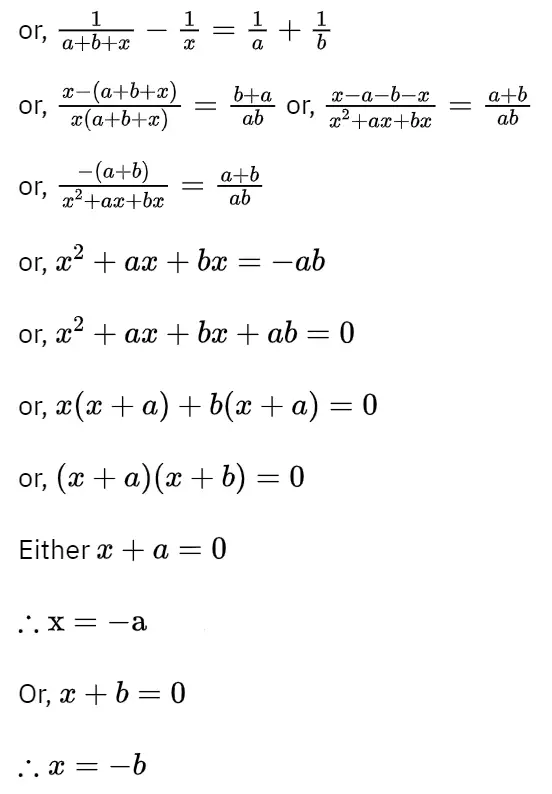
Or, The velocity of a boat is 8 km/h in the still water. The boat takes 5 hours to cover 15 km downstream and 6 km upstream. Find the velocity of the current.
Solution: Let the speed of current = x km/hr.
As the speed of the boat = is 8 km/hr.
∴ Speed of the boat with the current = (8 + x) km/hr.
& Speed of the boat against the current = (8x) km/hr.
∴ According to the problem,
15/8+x + 22/8-x
or, 15(8-x)+22 (8+x)/(8+x) (8-x) = 5
or, 120-15x+176 + 22x=5 (64 – x²)
or, 296 +7x=320-5x²
or, 5x²+7x-24=0
or, 5x² + 15x- 8x-24 = 0
or, 5x (x+3)-8 (x+3)=0 or, (x+3) (5x-8)= 0
Either x+3=0 ∴ x = – 3 (Not possible)
Or, 5x-8=0 ∴ 5x = 8
∴ X = 8/5
= 1 3/5 km/hr.
Question 5. √5/√3+√2 – 3√3/√2+√5 + 2√2/√3+√5
Solution: Given = √5/√3+√2 – 3√3/√2+√5 + 2√2/√3+√5 ———–(1)
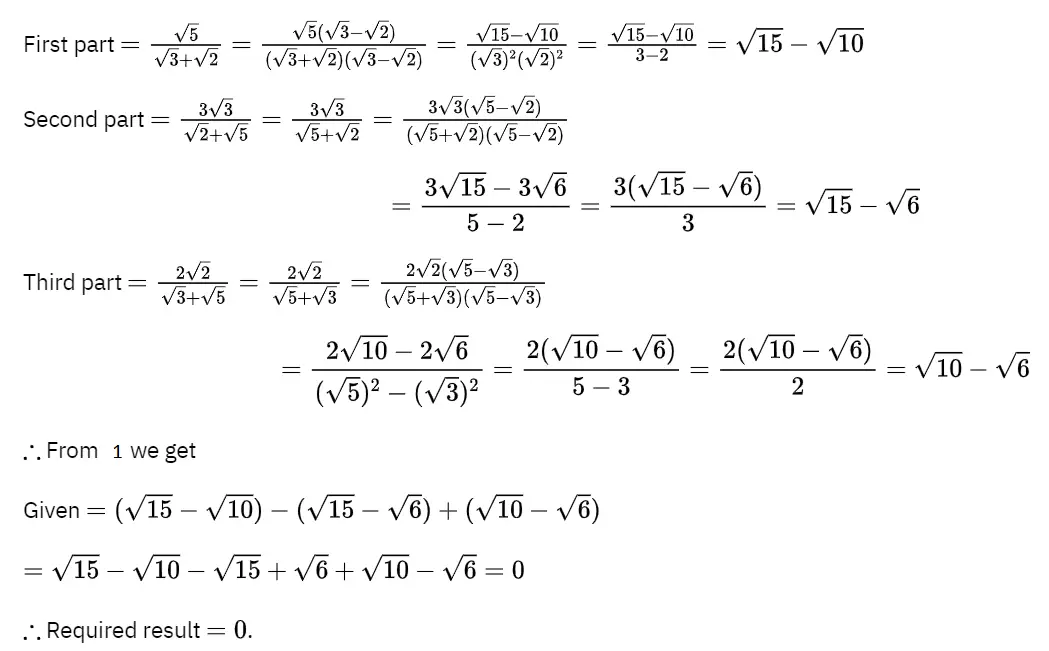
Or, If 5 men can harvest jute cultivated in 10 bighas of land in 12 days, how many farmers can harvest jute cultivated in 18 bighas in 9 days? Determine this by applying the variation theorem.
Solution: Let the number of farmers be A,
number of days be B and area of land be C
The number of farmers is in direct variation with the area, of land, when the number of days remains constant.
∴ A ∝ C, when B is constant.
Again, if the area of land remains constant, then the number of farmers is in inverse variation
with the number of days, i.e., Aα 1/B
when C is constant.
∴ According to the theorem on joint variation, A α C/B, when B and C both vary.
i.e., A = K C/B [where, K is non zero constant] ———–(1)
Given A= 5, B = 12 and C = 10
From (1) we get 5 K = 10/12
or, K = 5×12/10 ∴ K = 6
Now, putting the value of K in equation (1) we get A = 6 C/B ——–(2)
If B = 9 and C = 18 then, we get from (2), A = 6 x 18/9
= 12
∴ Required number of farmers = 12.
Question 6. If ay – bx / c = cx – az / b = bz – cy/a, proved that x/a = y/b = z/c.
Solution: ay – bx / c = cx – az / b = bz – cy/a
∴ c(ay – bx) + b(cx – az) + a(bz – cy) / c²+b²+a²
= cay -cbx + bcx – baz +abz – acy / c²+b²+a²
= 0 [using addendo we get]
so, ay – by / c = 0 or, ay – bx = 0
or, ay = by ∴ y/b = x/a
Again, cx – az / b = 0 or, cx = az ∴ x/a = z/c
∴ x/a = y/b = z/c [proved]
Or, If a,b, and c are in continued proportion, prove that a²b²c²(1/a³ + 1/b³ + 1/c³) = a³+b³+c³
Solution: To prove, a²b²c²(1/a³ + 1/b³ + 1/c³) = a³+b³+c³
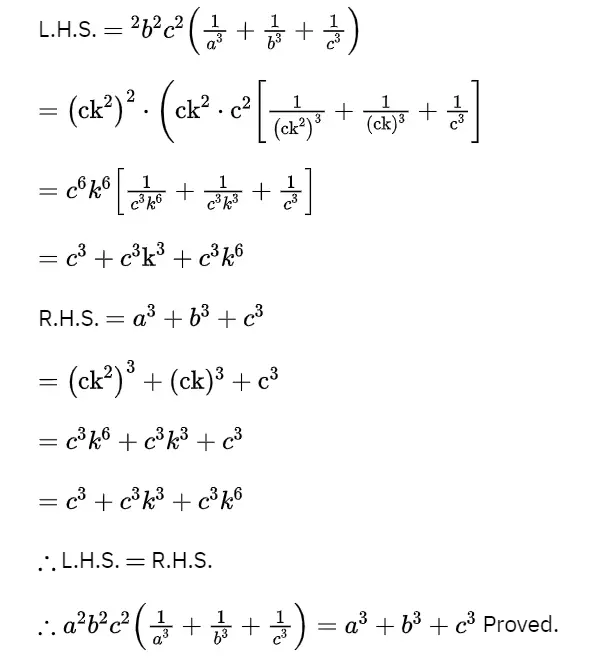
Question 7. State and prove Pythagoras’ theorem.
Solution:
Given: ABC is a right-angled triangle whose∠A is a right angle.
To prove: BC²= AB² + AC²
Construction: I draw a perpendicular AD on the
hypotenuse BC from the right angular point A which intersects the side BC at point D.
Proof: In right-angled triangle ABC, AD is perpendicular on the hypotenuse BC
∴ ΔABD and ΔCBA are similar.
Hence AB/BC = BD/AB, ∴ AB² = BC.BD———-(1)
Again, ΔCAD and AGBA are similar.
Hence, AC/BC = DC/AC, ∴ AC² = BC.DC
So, by adding (1) and (2), I get, AB²+ AC² = BC.BD + BC.DC
= BC(BD+ DC) = BC.BC= BC²
∴ BC² = AB²+ AC² Proved.
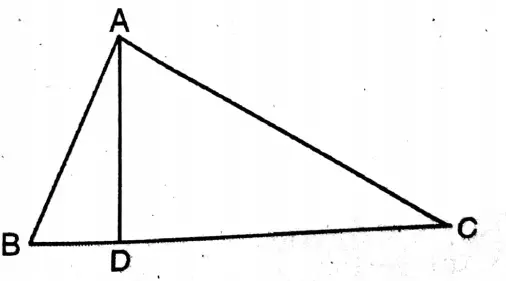
Or, Prove that the opposite angles of a cyclic quadrilateral are supplementary.
Solution:
Given: ABCD is a cyclic quadrilateral of a circle with center O.
To prove that: ∠ABC + ∠ADC= 2 right angles and <BAD +∠BCD 2 right angles
Construction: A, O, and C, O are joined.
Proof: ∠AOC is the reflex angle at the center and ABC is the angle at the circle arc formed with the circular area ADC.
∴ Reflex∠AOC = 2∠ABC
∴ ∠ABC = 1/2 reflex ∠AOC———(1)
Again, ∠AOC is the angle at the center and ZADC is the angle at the circle formed with the circular area ABC.
∴ ∠AOC = 2∠ADC
∴ ∠ADC = 1/2 ∠AOC———(2)
∴ From (1) and (2), we get∠ABC + ∠ADC
= 1/2(reflex ∠AOC+ ∠AOC)
= 1/2 x 4 right angles = 2 right angles
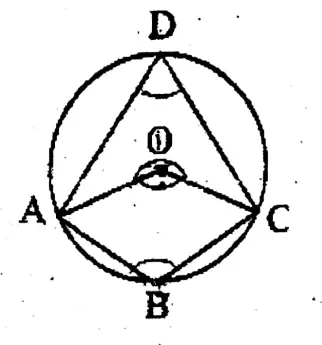
Similarly by joining B, O and D, O; it can be prove that /BAD + BCD = 2 right angles (Proved)
Alternative proof:
Given: ABCD is a cyclic quadrilateral.
To prove that: ∠ABC + ∠ADC= 2 right angles and ∠BAD + ∠BCD 2 right angles
Construction: Two diagonals AC and BD are drawn.
Proof: ∠ADB = ∠ACB [angle in the same segment of the circle] Again, BAC = BDC [angle in the same segment of the circle]
Again, ∠ADC = ∠ADB + ∠BDC=∠ACB + <BAC
∴ ∠ADC + ∠ABC = ∠ACB + ∠BAC + ∠ABC
∴ ∠ADC + ∠ABC= 2 right angles [sumof there angles of a triangle is 180°]
Similarly, we can prove that ∠BAD + ∠BCD = 2 right angles. Proved.
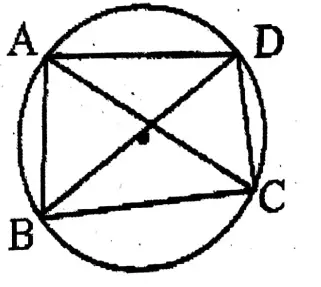
Question 8. ABCD is a trapezium of which AB || DC; a straight line parallel to AB intersects AD and BC at the points E and F respectively. Prove that AE: ED = BE: FC.
Solution:
Given: AB | DC in the trapezium ABCD; the straight line parallel to AB has intersected AD and BC at the points E and F respectively.
To prove: AE: ED = BF: FC.
Construction: I joined A, C which has intersected EF at the point G.
Proof: In ΔADC, DC || EF
So, from Thales theorem, we get, AE/ED
= AG/GC ———(1)
Again, in ΔACB, AB || FG
∴ From Thales theorem, we get, AG/GC
= BF/FC ———(2)
So, from (1) and (2), we get AE/ED = BF/FC
∴ AE ED = BF: FC

Or, In a cyclic quadrilateral ABCD if AB = DC, prove that AC = BD.
Solution: ABCD is a cyclic quadrilateral.
∴ AB = DC
To prove AC BD
In ΔABC & ABCD,
(1) AB = CD, BC is common
∠DBC = ∠BAC (angle on same arc)
∴ ΔABC ≅ ΔBCD
∴ AC = BD.
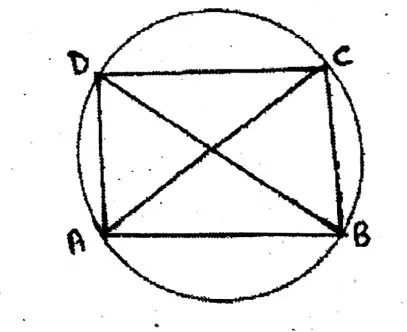
Question 9. Find the value of √22 geometrically.
Solution: 22=5 x 4.4
From AX, cut AB = 5 cm & BC = 4.4 cm.
O is the midpoint of AC.
Draw a semicircle with center O.
Now draw a perpendicular at B on AC, which cuts the semicircle at D.
Length of BD is the value of √22 = 4.7 (approx)
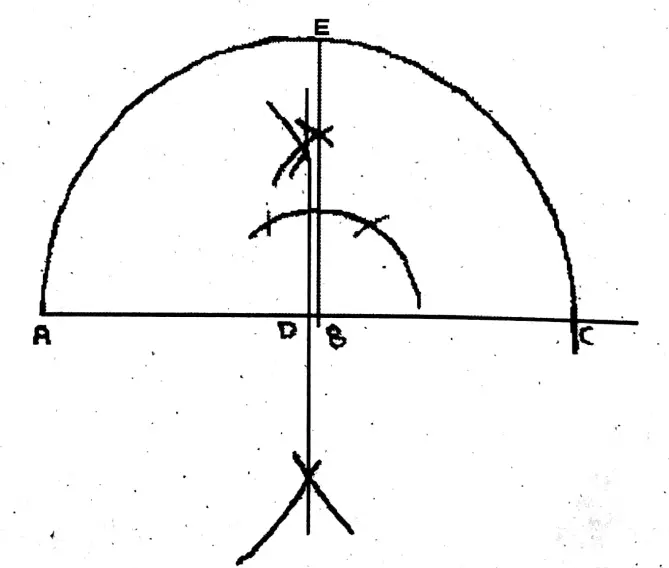
Or, Draw a triangle having a side of 6.5 cm in length and measures of two angles adjacent to the side are 50° and 75°. Draw the in-circle of that triangle.
Solution: ABC is an A whose
C = 75° & B = 50°, BC = 6.5 cm.
O is the center of the incircle.
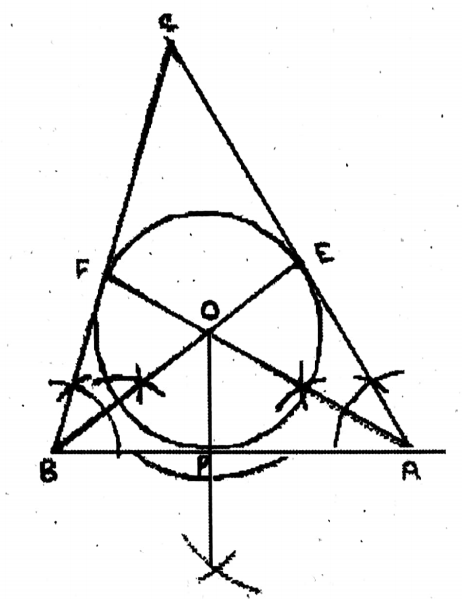
Question 10. Answer any two questions :
1. Find the value of x from the equation (x + 1) cot² Π/6= 2cos²Π/3 +3/4 sec²Π/4 +4sin²Π/6
Solution: (x + 1) cot² Π/6= 2cos²Π/3 +3/4 sec²Π/4 +4sin²Π/6
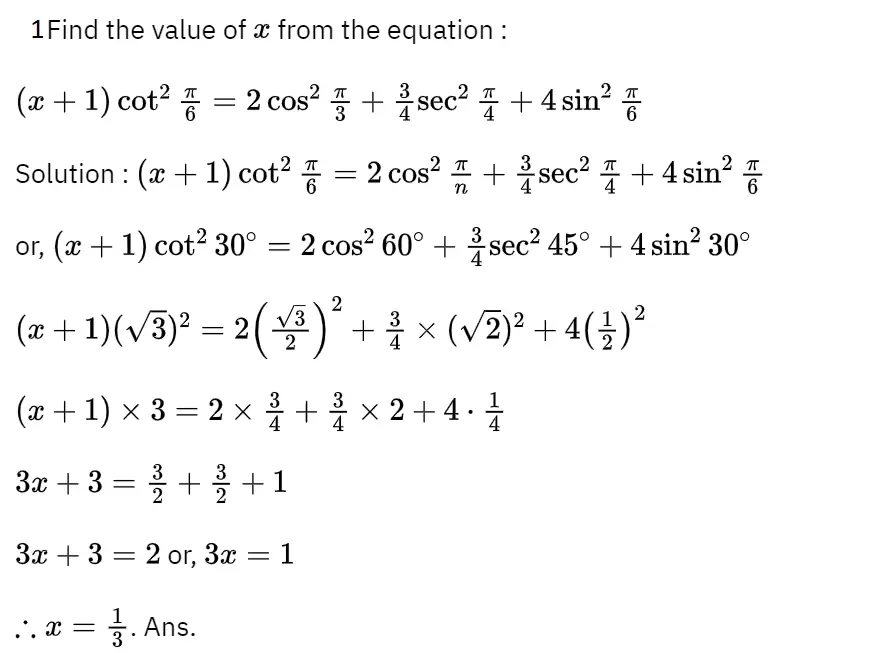
2. Show that cosec²22° cot 68° = sin² 22° + sin²68° + cot²68°.
Solution: L.H.S. = cosec²22°. cot²68°
=cosec²(90° – 68°) cot²68°
= sec²68°. cot²68°
= 1/cos² 68° x cos² 68° / sin² 68°
= 1/sin² 68°
= cosec²68°
R.H.S= sin²22° + sin²68° + cot²68°
= sin²(90° – 68°) + sin²68° + cot²68°
= cos²68° + sin²68° + cot²68°
= 1 + cot²68°
=cosec²68°
∴ L.H.S. = R.H.S.
3. If cose = X/√x²+ y², show that x sine = y cose.
Solution: sinθ = √1-cos²0 =√1 – (x/√x²+y²)²
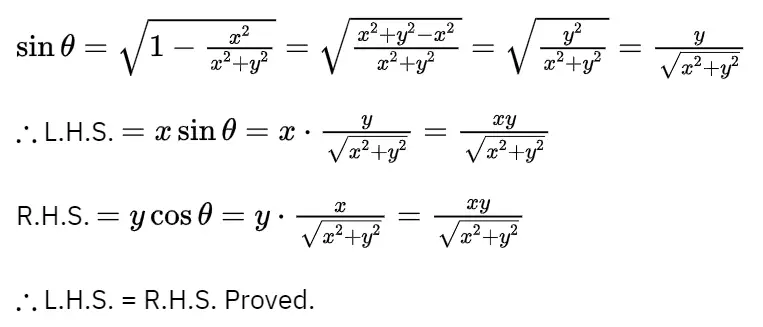
Question 11.
1. A hemisphere and a cone have an equal base and their heights are also equal, find the ratio of their volumes and the ratio of their curved surface areas.
Solution: Height of hemisphere = Radius of base = r
Height of cone Radius of base = r
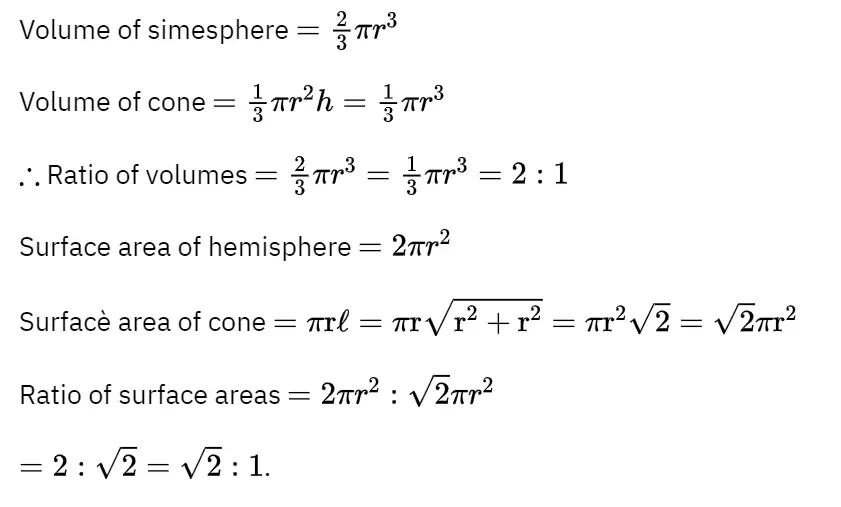
2. Find the volume of a right circular cone obtained from a wooden cube of 4.2 dcm edge by wasting minimum quantity of wood.
Solution: Here diameter of base of the cone one edge of cube.
Radius = 4.2 / 2
= 2.1 dcm
= 21 cm
Height of cone one edge of cube = 42 cm..
Volume= 1/3г²h= X
= 1/3 x 22/7 x 21 x 21 x 42 cu cm.
= 22 x 21 x 42 cu cm
= 19404 cu cm.
∴ Volume of cone = 19404 cu cm. Ans.
3. Height of a right circular cylinder is twice of its radius. If the height would be 6 times of its radius, then the volume of the cylinder would be greater by 539 cubic dm. Find the the height of the cylinder.
Solution:
Height of a right circular cylinder is twice of its radius. If the height would be 6 times of its radius, then the volume of the cylinder would be greater by 539 cubic dm.
Let the height of the cylinder = h dcm & radius = r dcm.
∴ h = 2r
Volume of the cylinder = r² x 2r= 2πr³
If height h = 6r, volume = r² x 6r = 6πr³
According to the problem, 6r³-2r³ = 539
4πr³ = 539
or, 4 x 22/7 r3 = 539
∴ r³ = 539 x 7 / 88
= (7/2)³
∴ r= 7/2
∴ 2r= 7.
∴ Height = 2r = 7dcm.
Question 12. The angle of elevation and the angles of depression of the top and foot of the monument, when observed from a point on the roof of a five-storied building of Mihir, are 60° and 30° respectively. If the height of the building is 16 metre, what will be the height of the monument ?
Solution:
The angle of elevation and the angles of depression of the top and foot of the monument, when observed from a point on the roof of a five-storied building of Mihir, are 60° and 30° respectively.
Let AB 16 m Height of the building
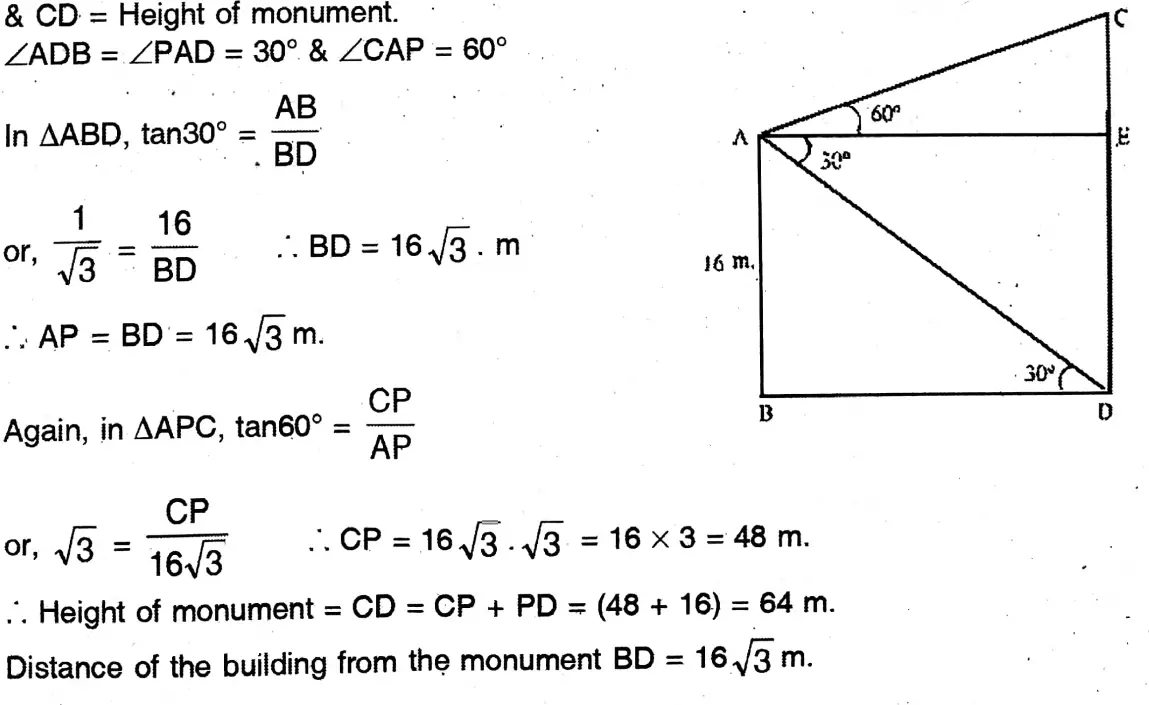
Or, When the angle of elevation of the sun changes from 45° to 60°, the length of shadow of a telegraph post changes to 4 metres. When the angle of elevation of the sun is 30°, then find the length of shadow of the telegraph post.
Solution: In APQR
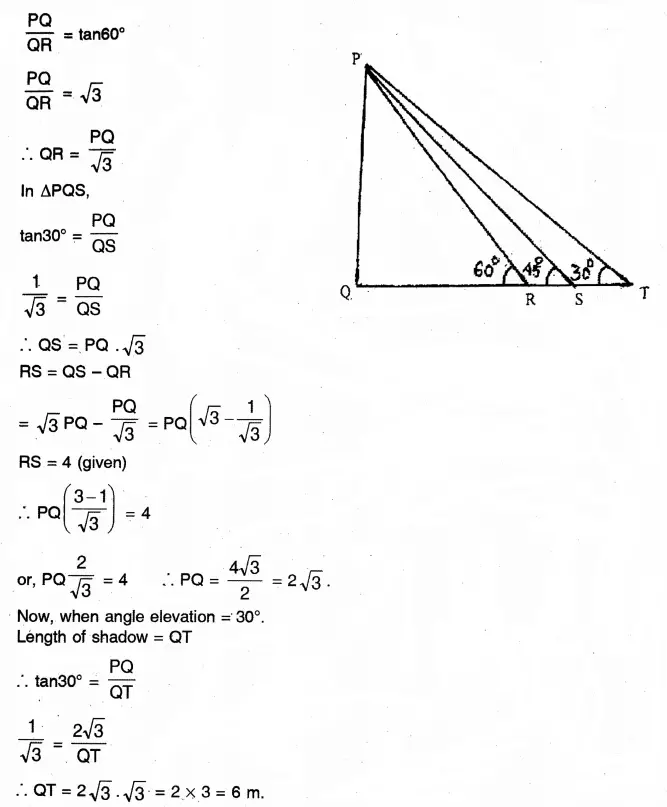
Question 13. Answer any two questions:
1. Shakil babu would bring mangoes kept in 50 packing boxes in the retail market. These boxes contained varying number of mangoes. The following is the distribution of mangoes according to the number of boxes.

Find the mean number of mangoes kept in 50 packing boxes.
Solution:
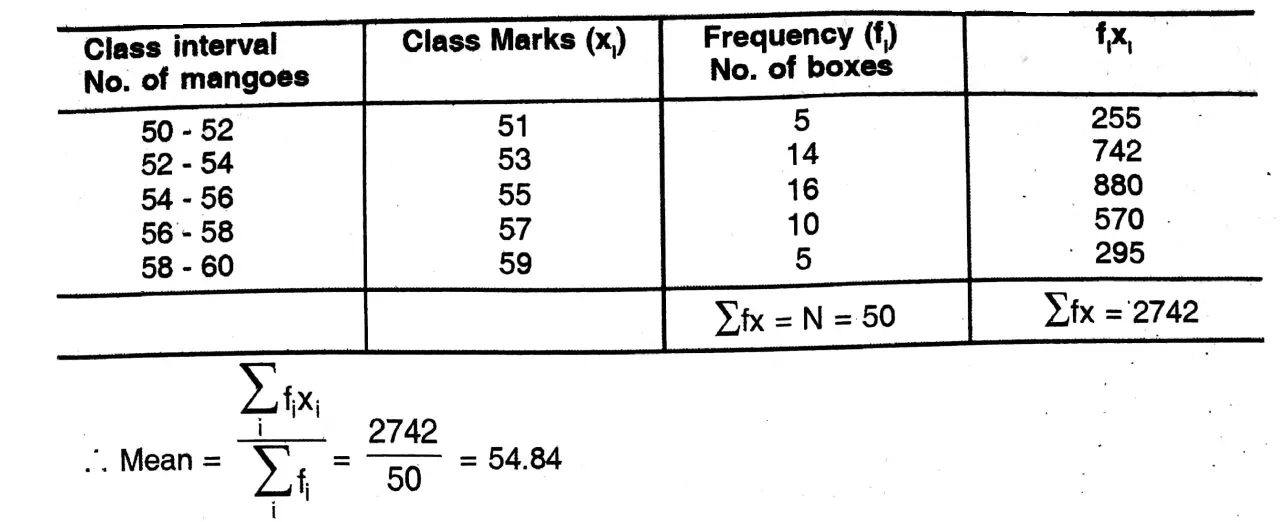
2. Find the mean of heights of students from the following distribution table

Solution:
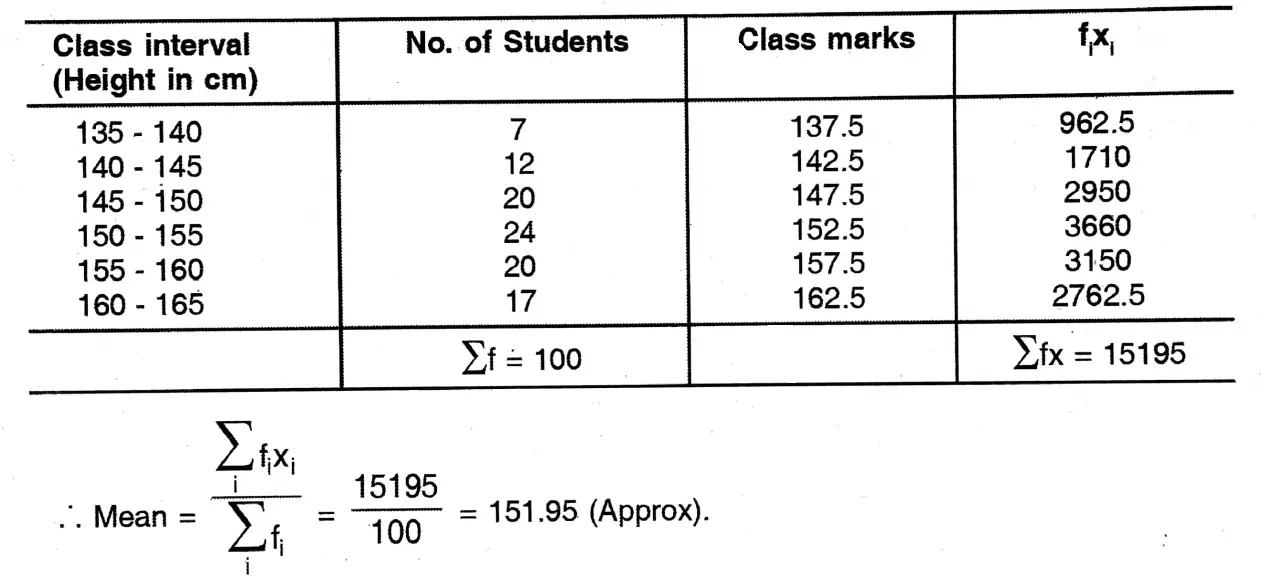
3. Find the mode of the following frequency distribution table

Solution:



